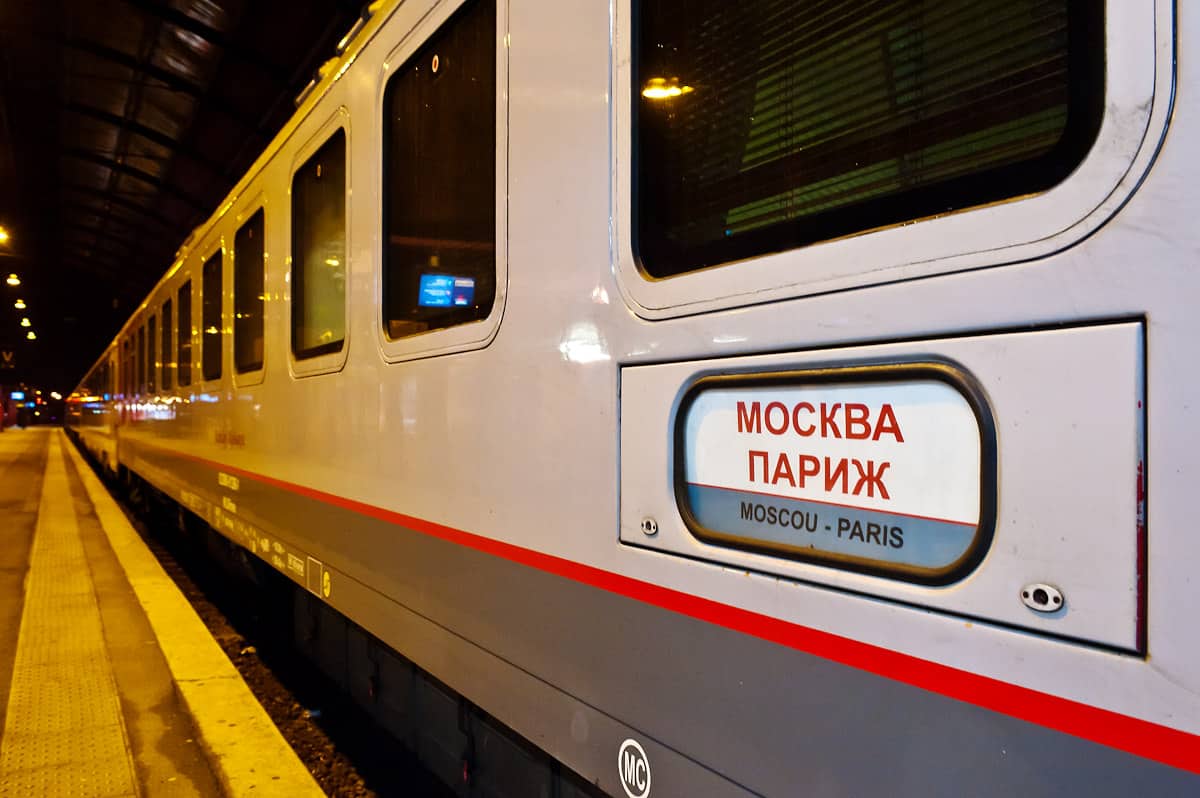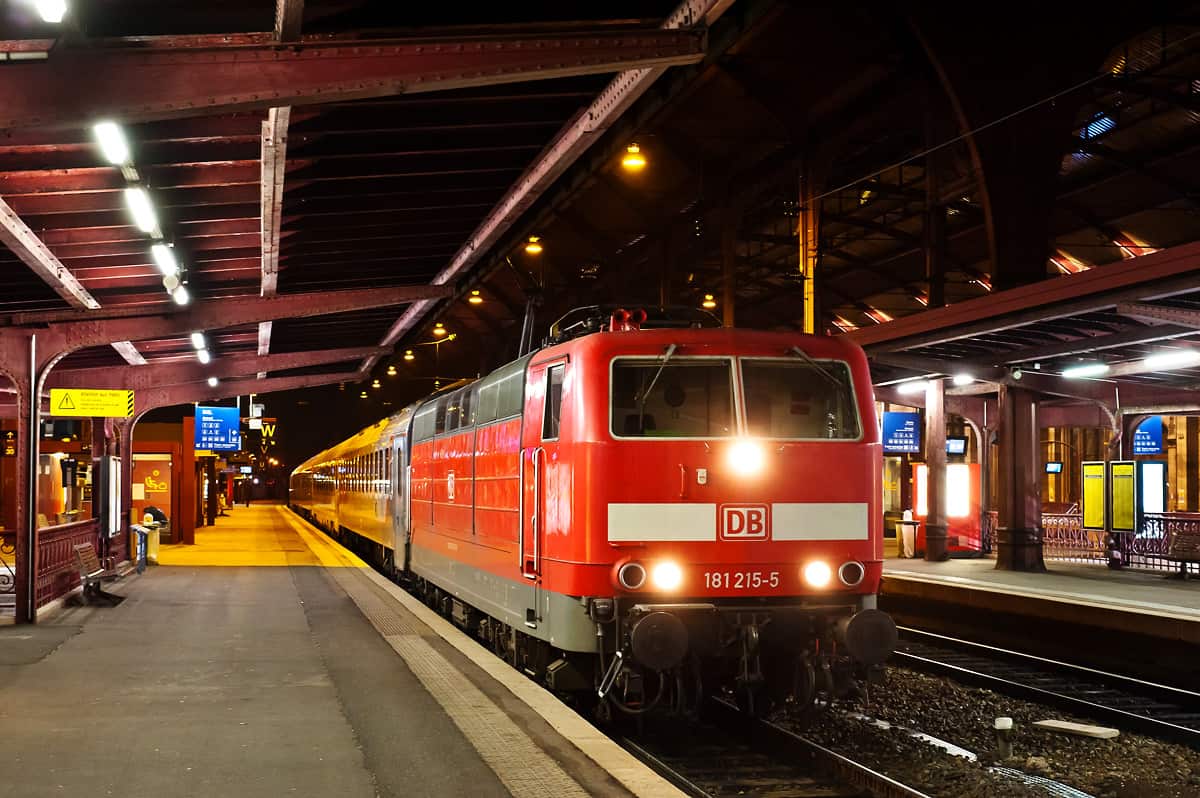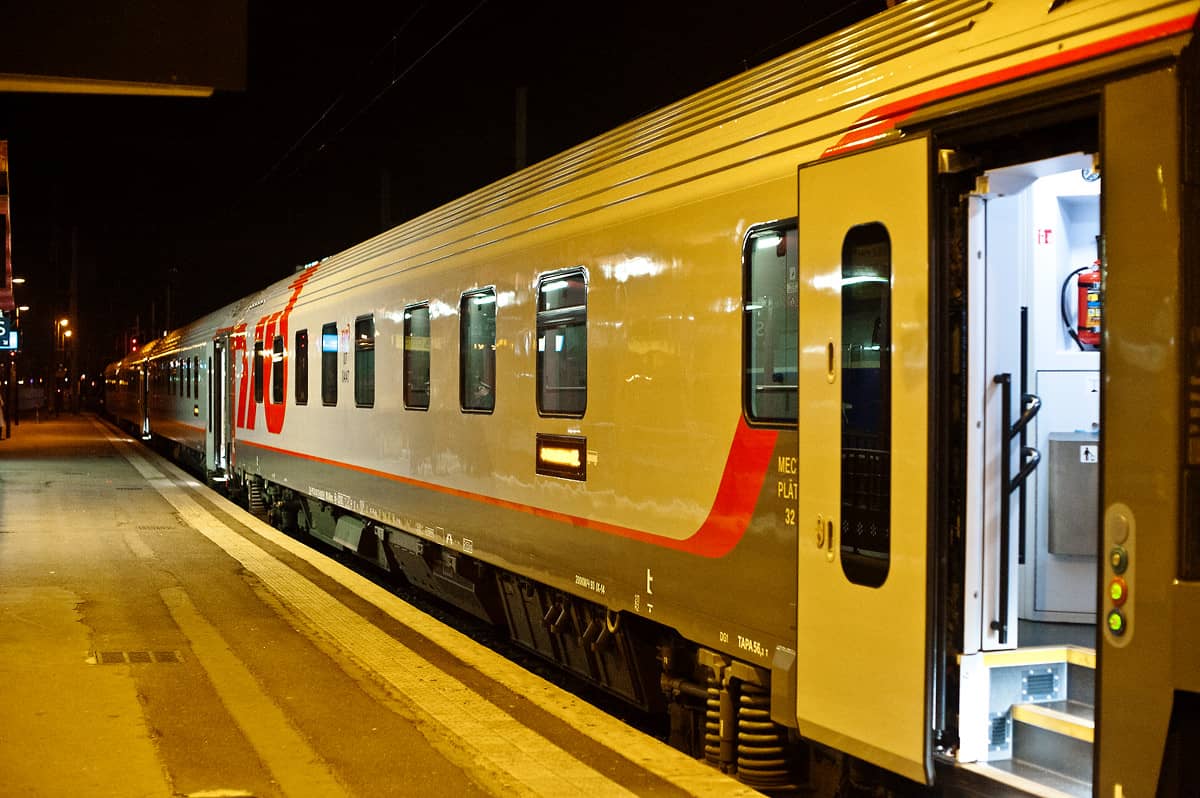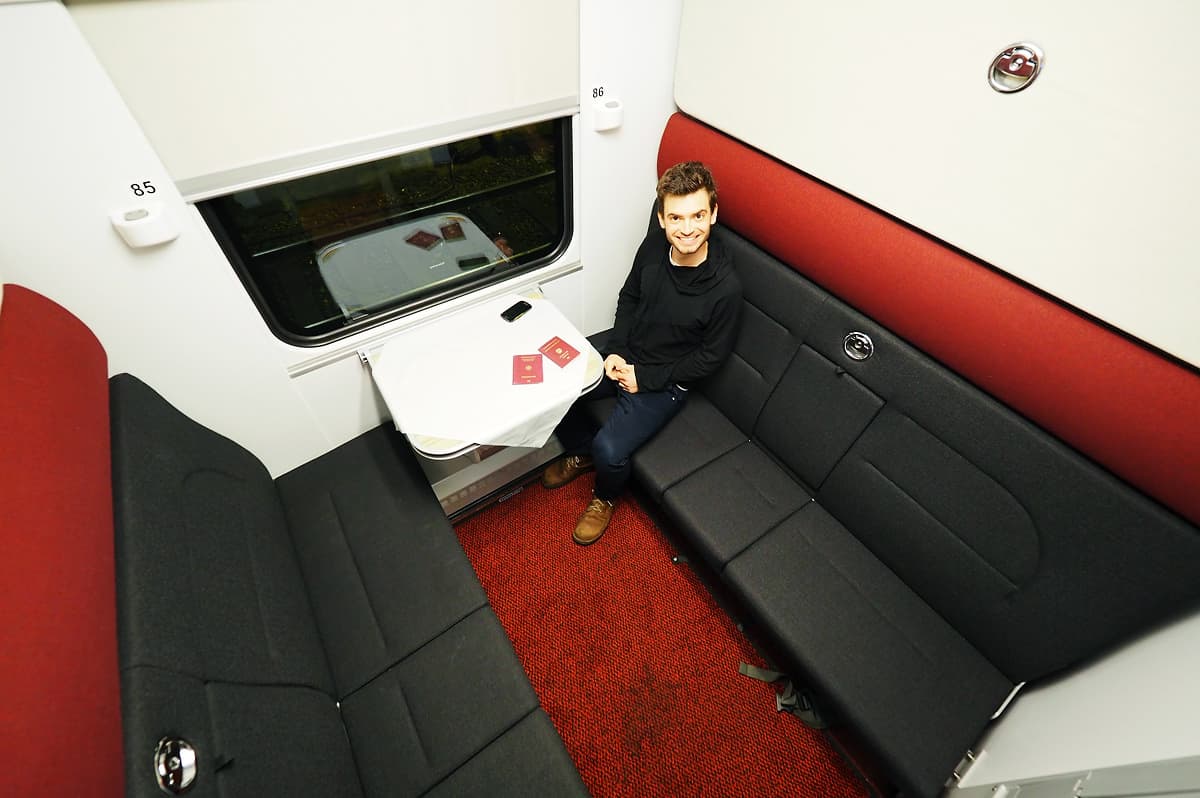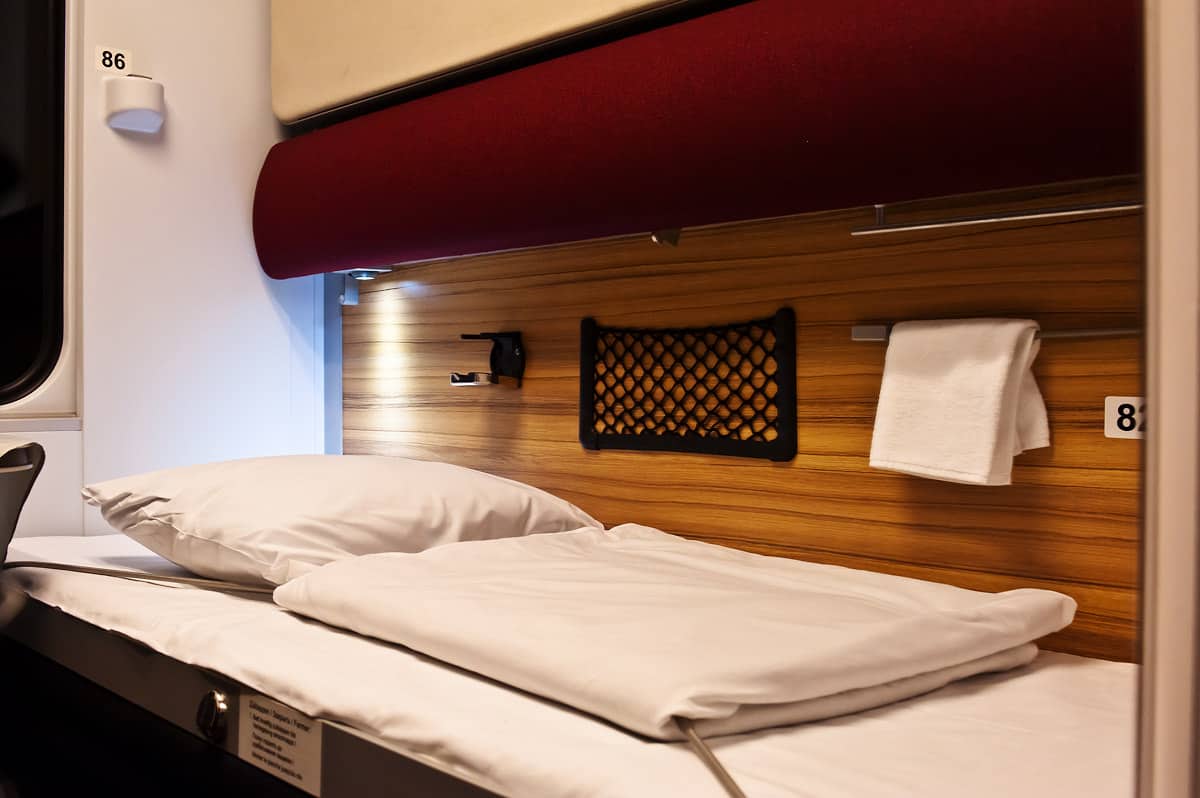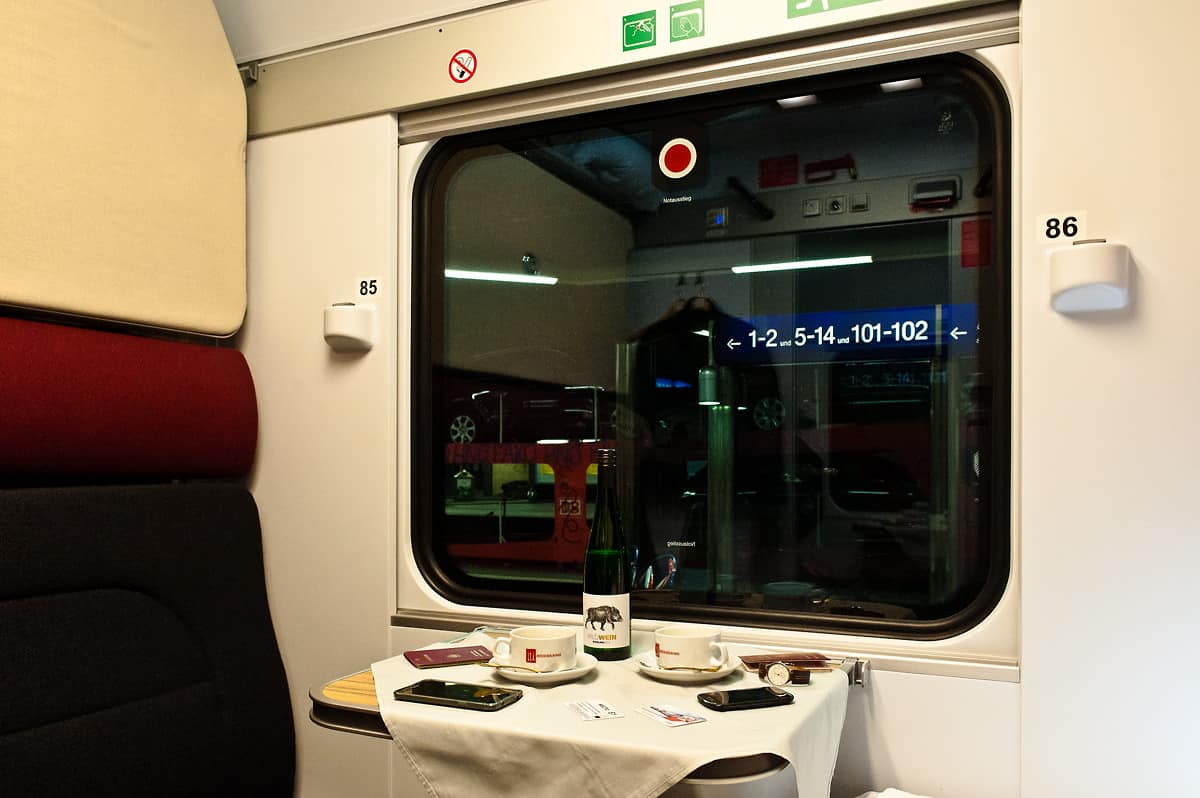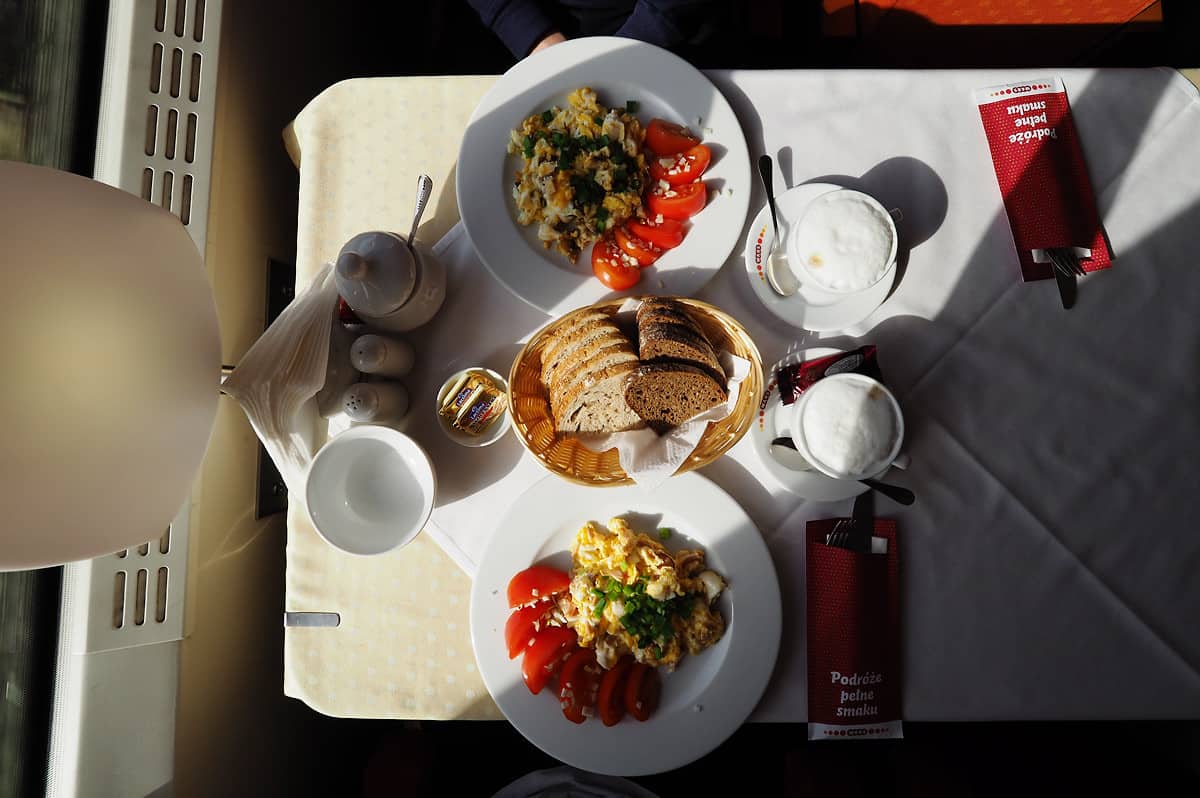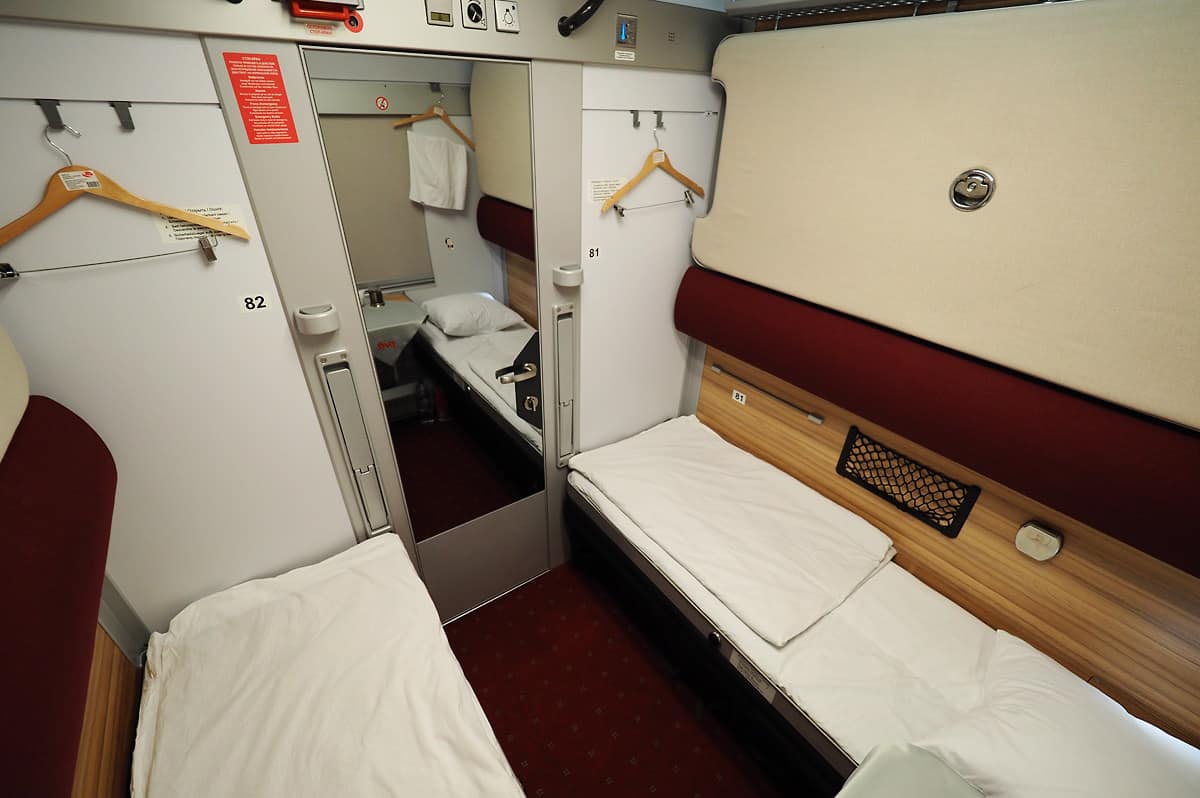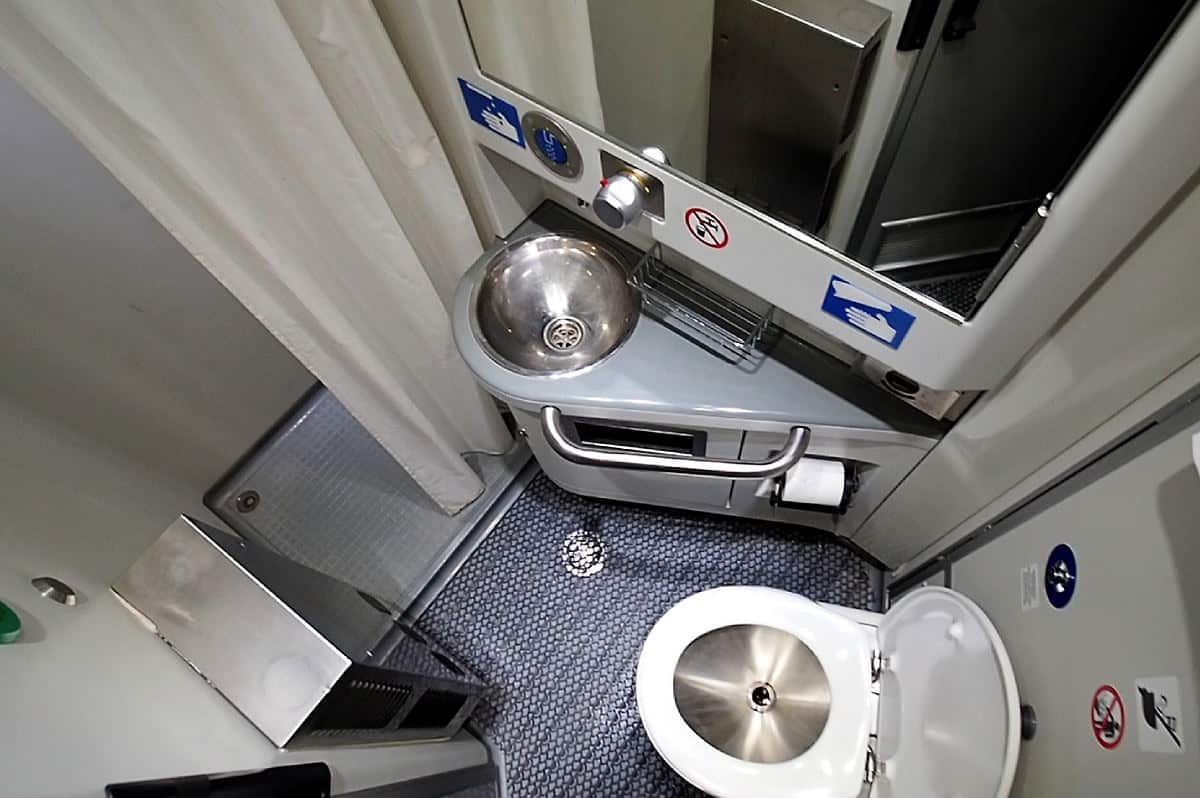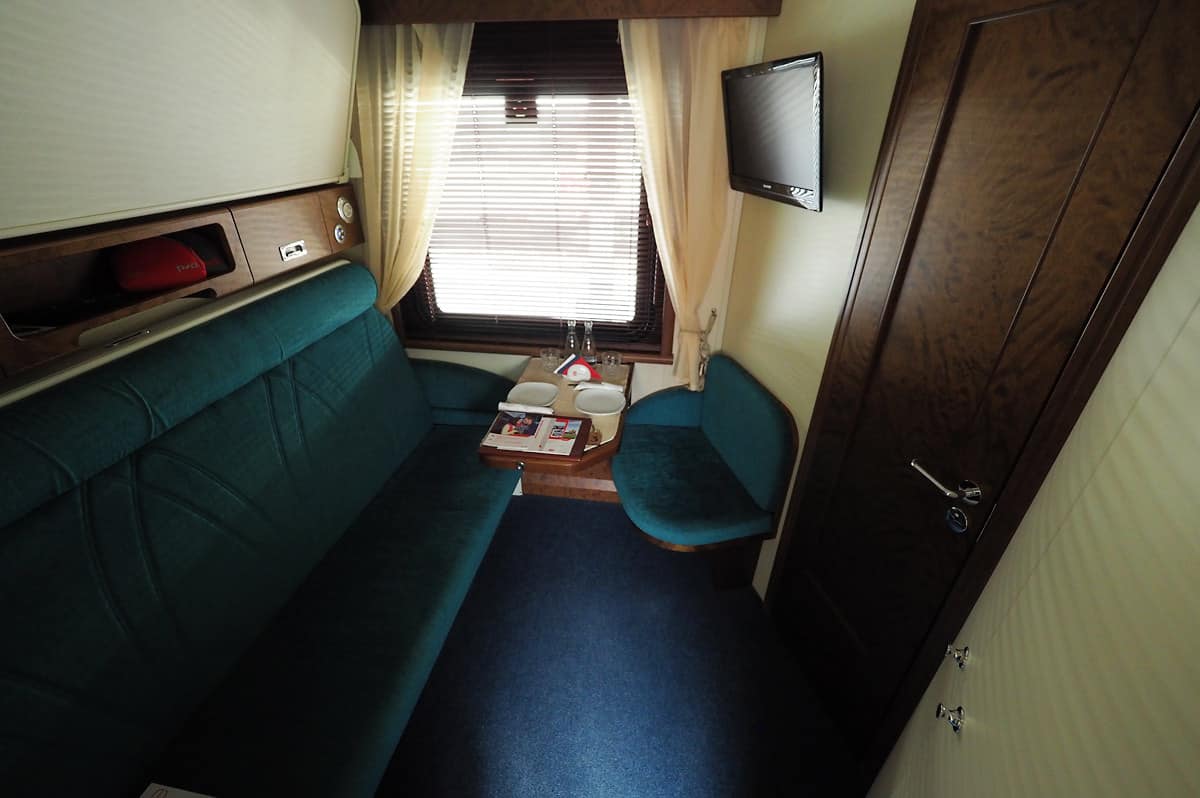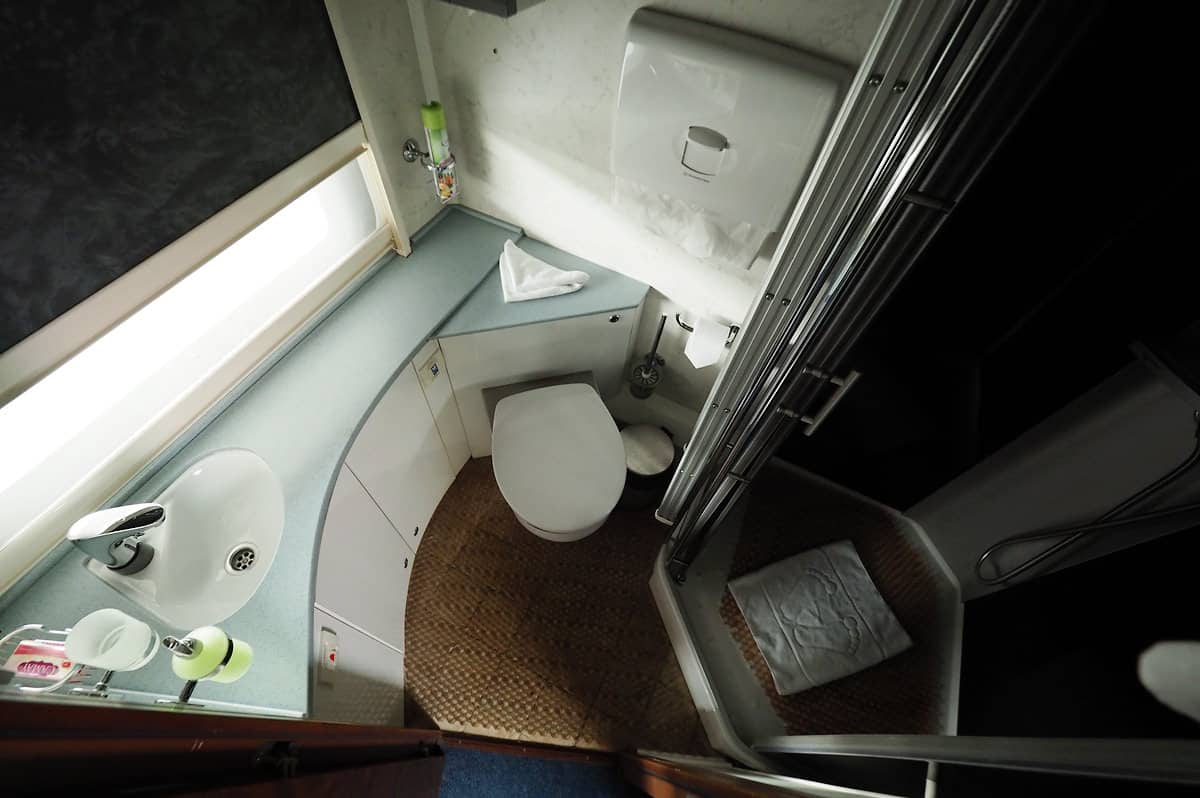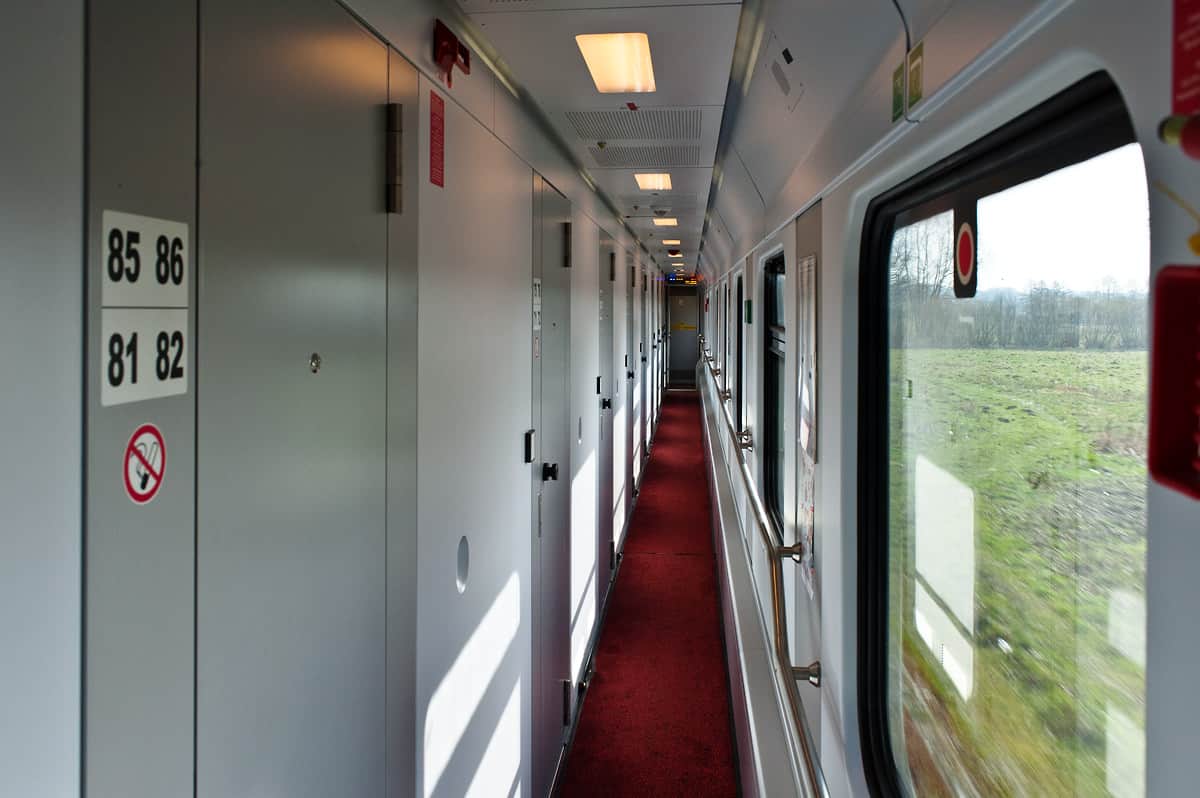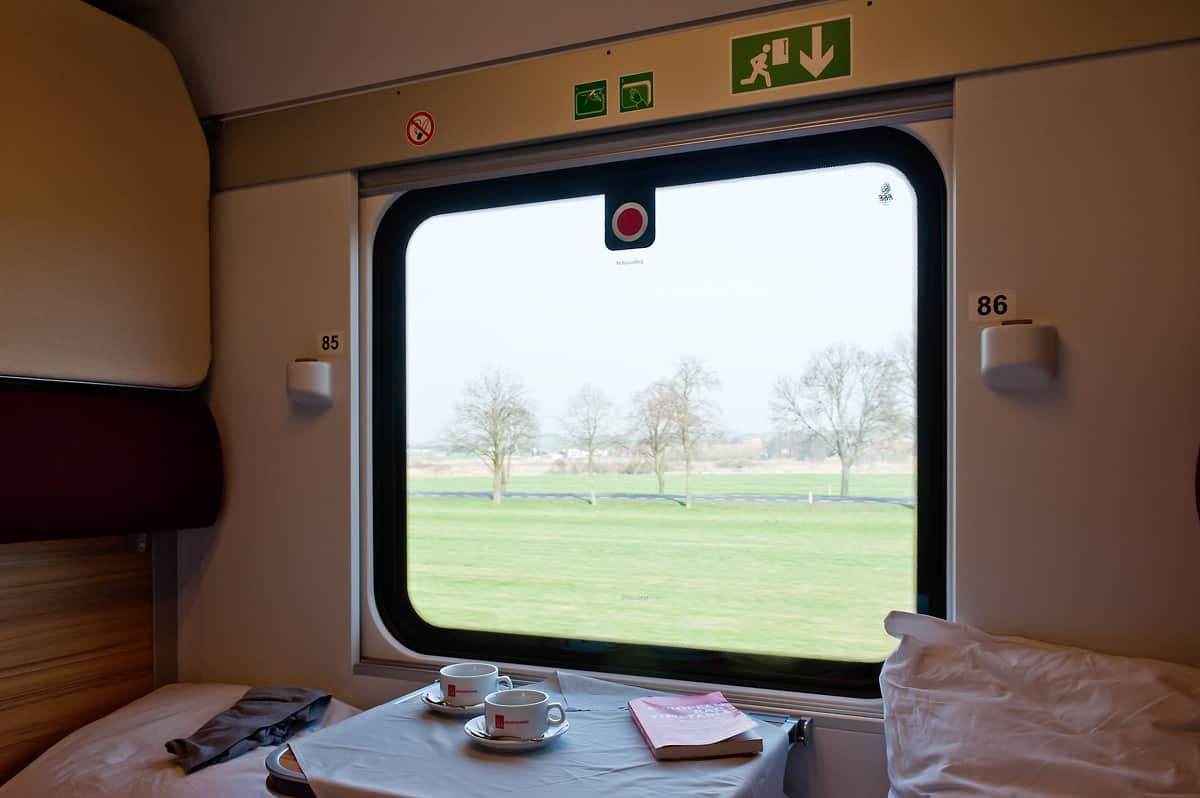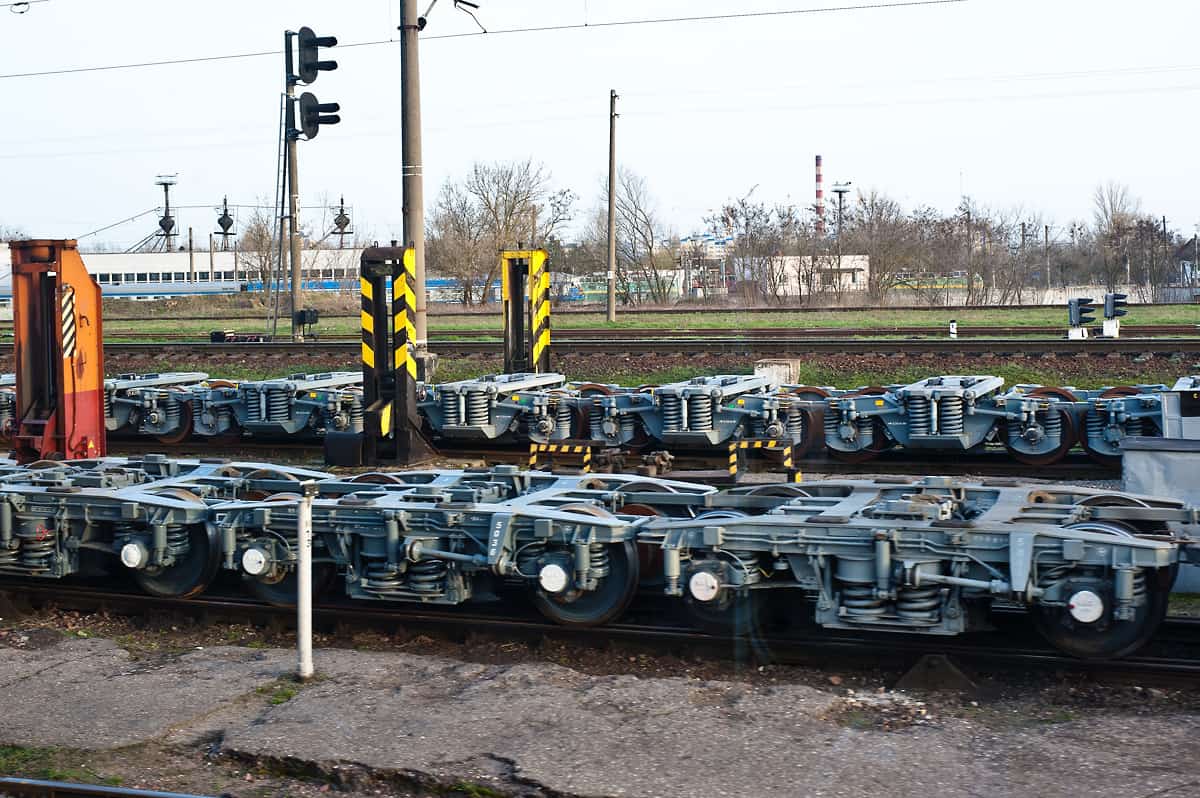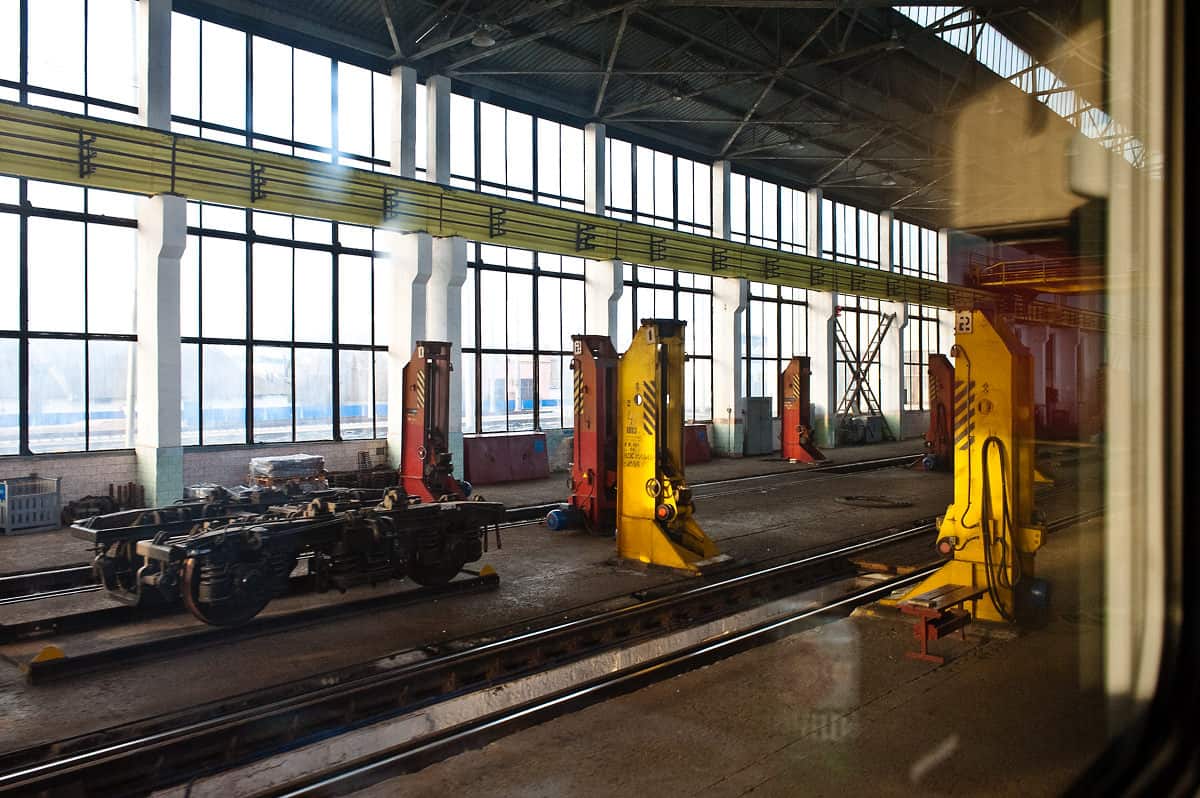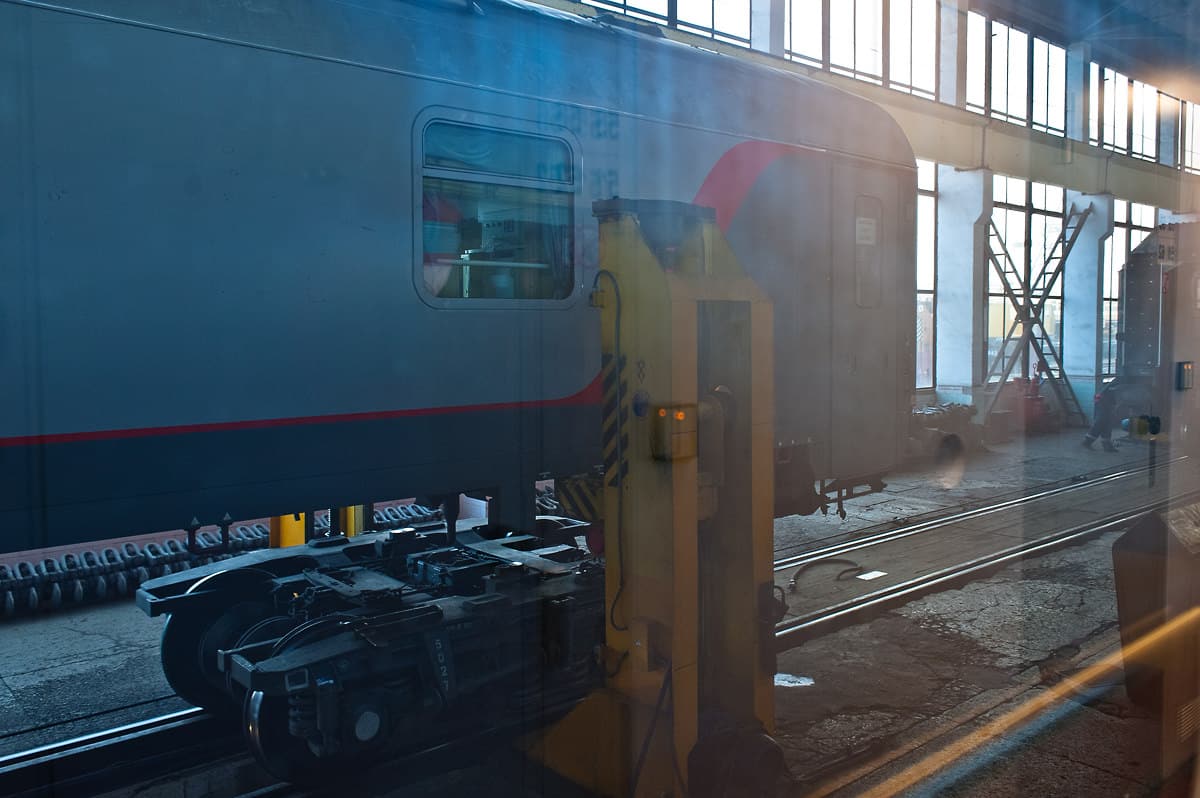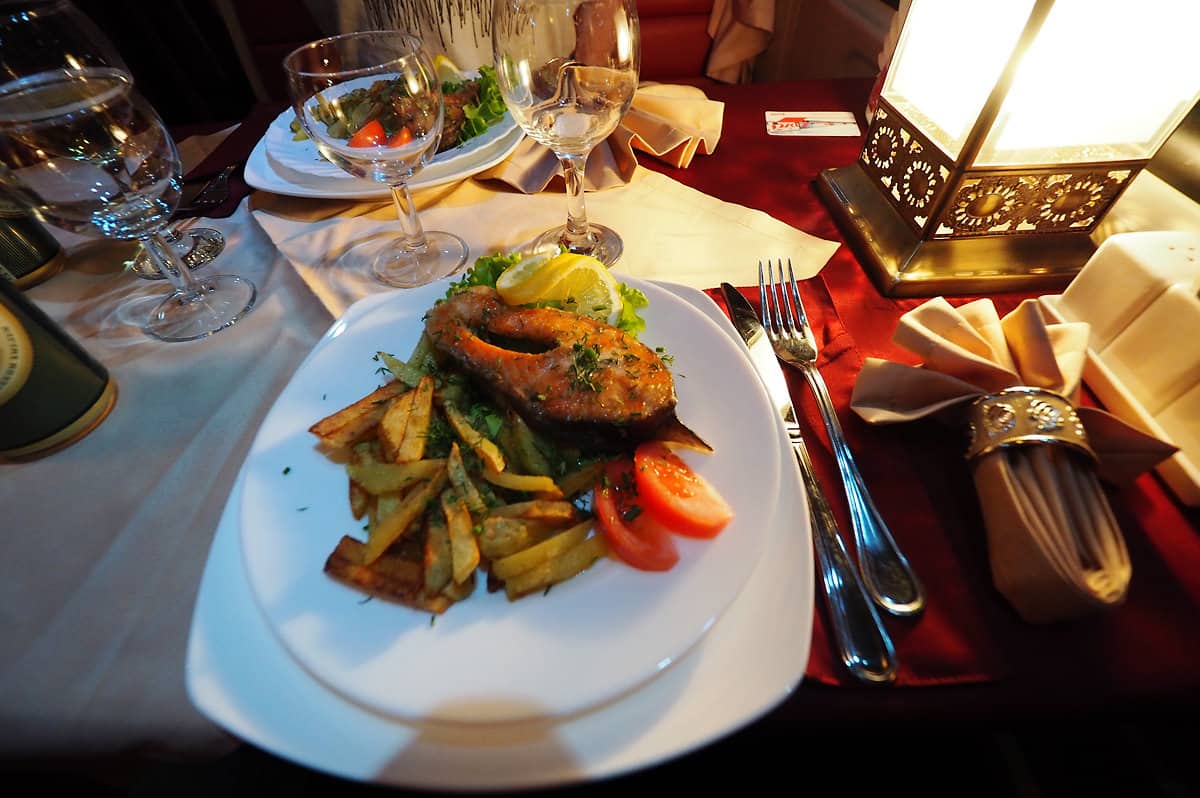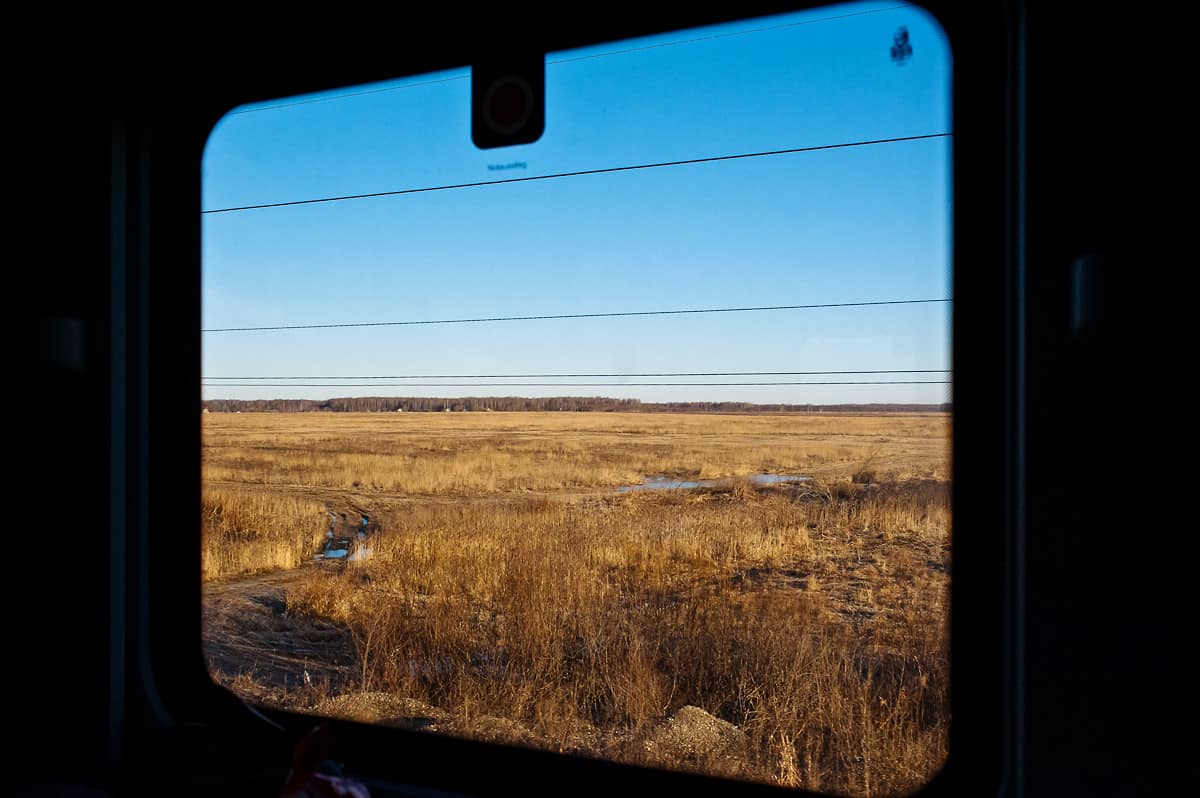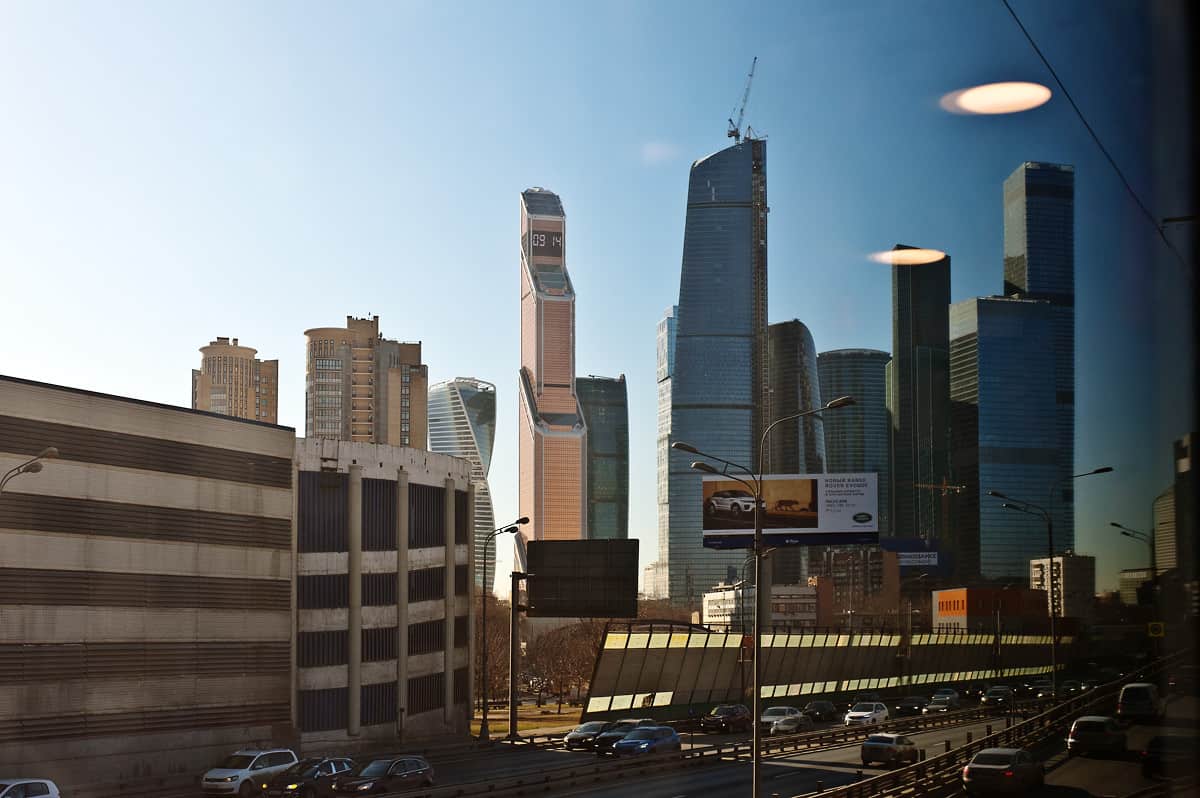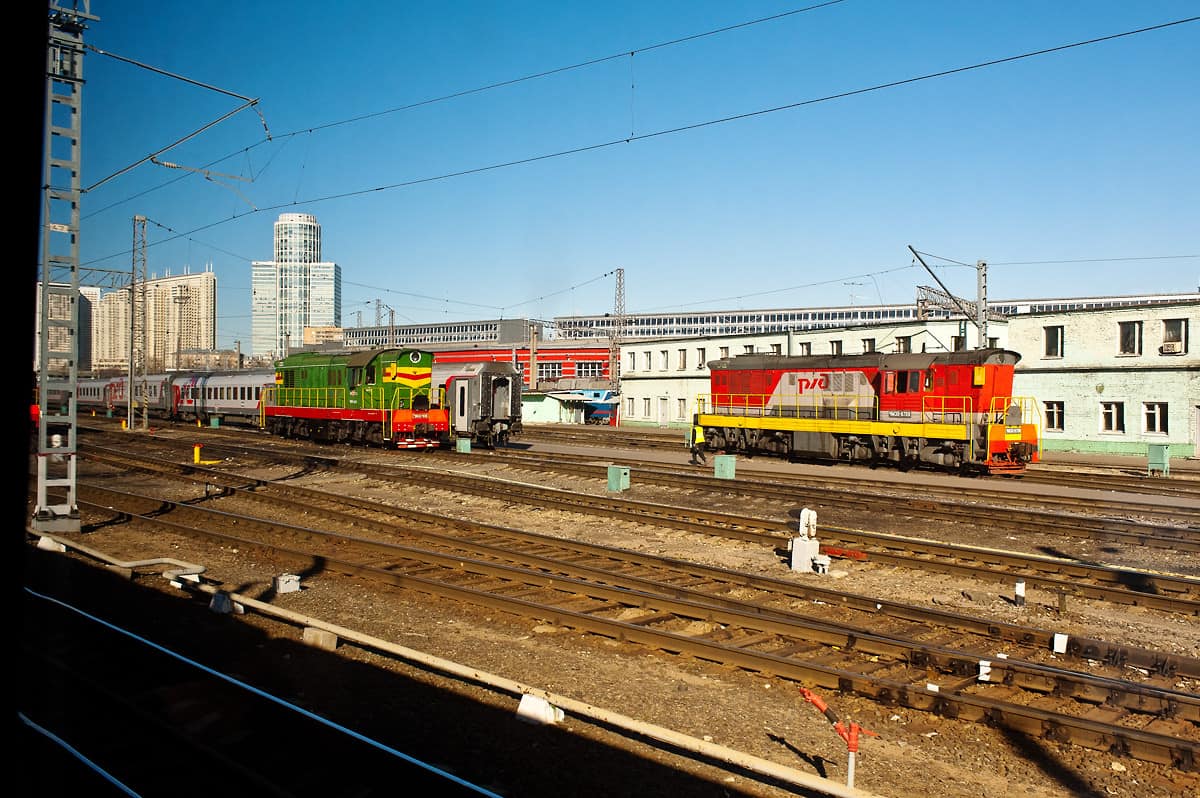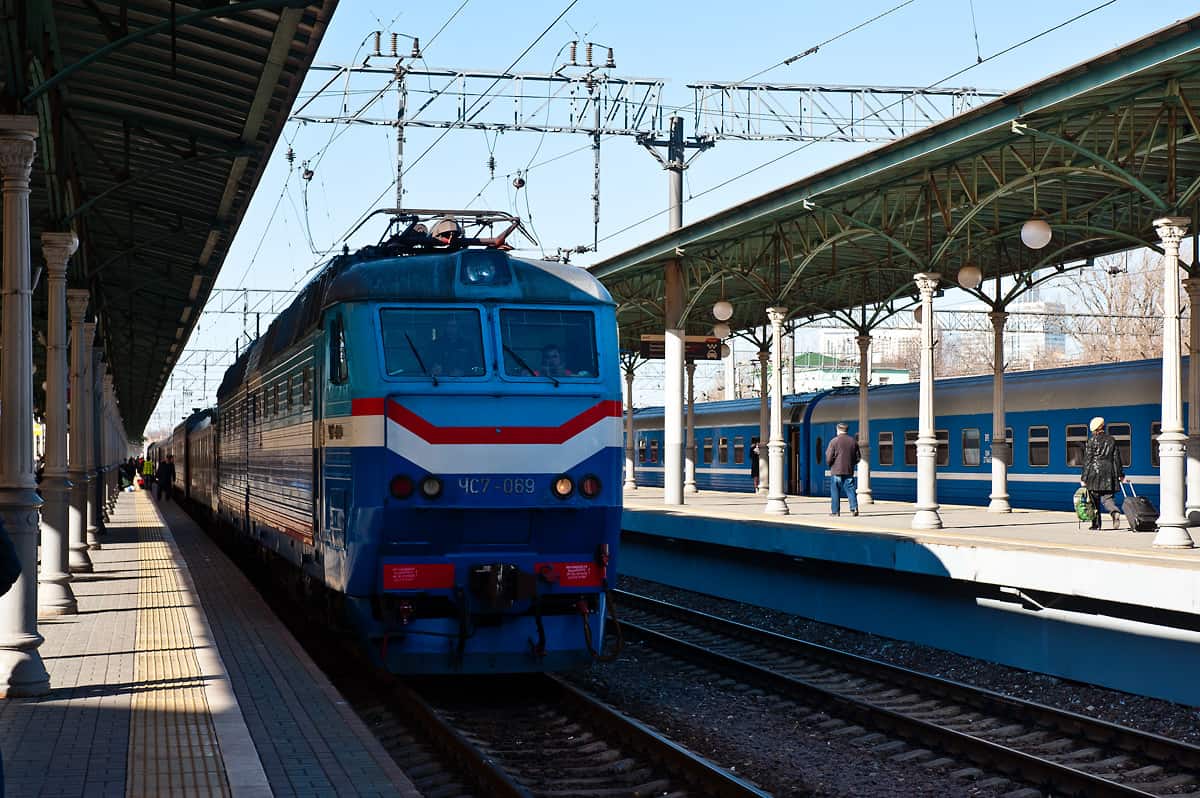The "Transeuropean Express" from Paris to Moscow, operated by Russian Railways RZD, is without a doubt one of the most fascinating night trains currently running on the European rail network. Within 36 hours it connects the City of Love on the Seine with the capital of Russia on the Moskva, covering more than 3000 kilometres which you can spend in comfortable sleeping cars. Peter and I travelled from Strasbourg to Moscow and from Moscow to Paris back in April. Two nights in the sleeping car across Europe - join us on this cruise on rails and get all the information you need to know for planning your own trip. For even more photos and the detailed schedules have a look on rail.cc. Tickets can be bought via Russiantrain (einfaches Buchungssystem), Infotrain or RZD.
Important notice: Since autumn 2016 there have been reports about problems at the border between Belarus and Russia. It seems that the border between the two states now is open only for citizens of these countries only, as there is no international border check point at this border. Citizens from other countries have to use an international border check point to enter Russia, such as one of the Moscow airports or at the borders between Finland, Estonia and Latvia to Russia. Information from the Russian Ministry of Transport from March 2017 suggests that the train route through Belarus is exempt from the new regulations. Passengers can use the trains from Europe through Belarus to Russia without problems, as long as they have the required visas for both countries. As of April 2018, the situation is still unchanged - while there is no official solution yet it seems that international passengers can still use these trains without problems.
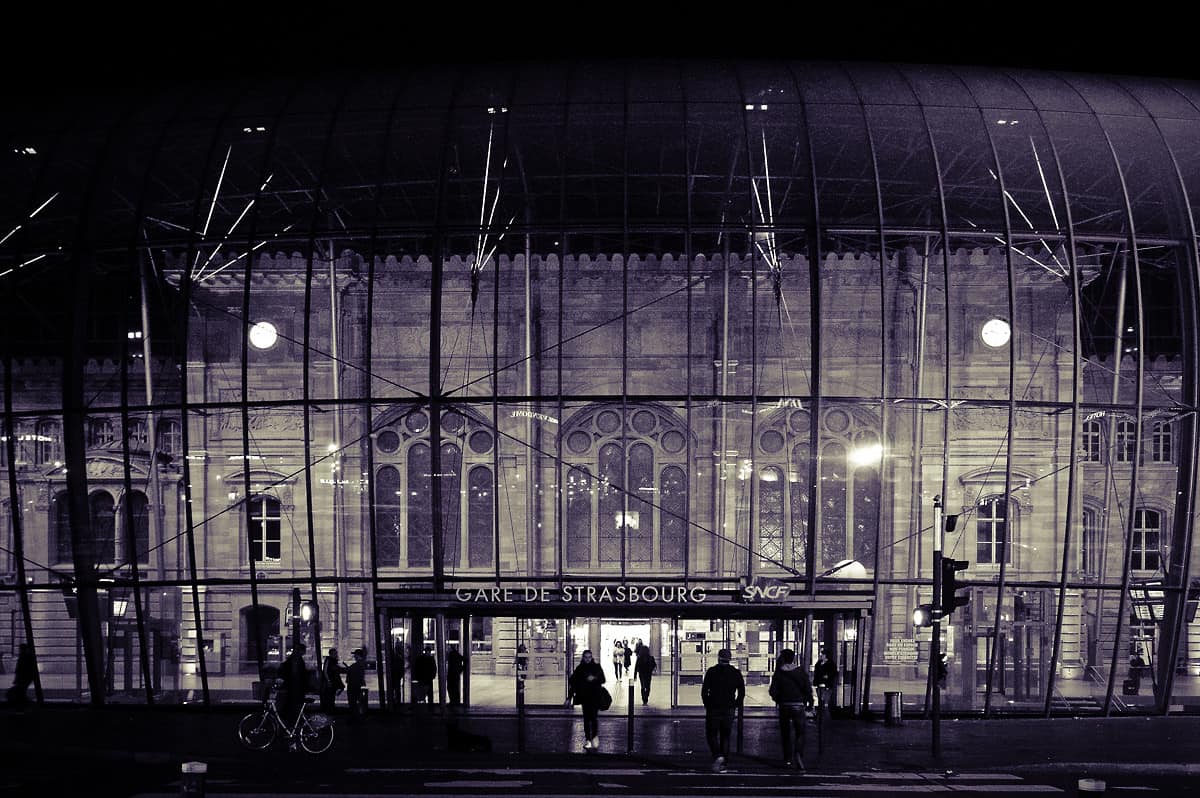
We start our journey at the impressive Strasbourg station.
So here we are, on a late Sunday evening at the station in Strasbourg. With its spectacular new glass structure in front of the old station building it certainly has its place amongst my favourite stations in Europe. At ten in the evening the station is quite empty already, the shops are closing and only a handful of passengers are still here, arriving or waiting for one of the last trains leaving. While we are waiting for our night train to Moscow to show up on the departure screens let me quickly answer the question why we didn't board the train in Paris already. Well, the answer is simple: in April, two of the three weekly trains from Paris to Moscow were suspended between Paris and Strasbourg due to construction works. Since we had to be in Moscow on a certain date we had to choose one of the trains that started from Strasbourg, but we will travel all the way from Moscow to Paris when we return. Update: From December 2016 the train will run only once weekly (Leaving Moscow on Wednesdays, leaving Paris on Fridays).
Paris 18:58 - 07:29 Berlin
The departure of our train in Strasbourg is scheduled at 23:50 and normally it would arrive from Paris at 23:25. As mentioned above we unfortunately miss out on the journey through the Champagne in the evening (as well as on enjoying dinner in the restaurant car) today. Anyway, we will deal with that on our return trip. Now we are looking forward to the trip to Moscow and hope that the train will be ready to board soon. Indeed the train slowly rolls onto the platform at 23:00: seven sleeping cars and restaurant cars. As the doors open and the Provodnizas and Provodniks (russ. "conductor") in spotless uniforms position themselves in front of each coach we walk to our coach, number 255. The conductor checks our tickets and shows us to our compartment. We get rid of our backpacks and have a closer look at our home for the following two nights.
Our two-bed compartment is quite bright and spacious at first glance. The arrangement with two beds (upper and lower) on each side is a quite unusual sight in European sleepers (I've seen this arrangement only in Spanish Talgo trains), but this results in a much bigger compartment compared to other sleepers with three beds on one side. Apart from a more spacious compartment this makes in much more convenient to talk with fellow travellers, as you can sit opposite each other. If the compartment is booked as a two-bed compartment, the upper two beds remain folded to the wall. As in other sleeping cars, the lower bed converts to seats for daytime use if folded against the wall - but as the beds are really comfy, you might also stay in bed a bit longer. There is a big table at the window, complete with tablecloth and a tea service, of course branded with the logo of RZD and the Transeuropean Express. Beneath the table you will find a washbasin, so you can wash your hands and brush your teeth in the cabin. The compartments can be locked with key cards, allowing to leave your luggage securely behind if you go to the restaurant car. At one end of the coach there are two toilets, one of them also has a shower, so you don't have to give up any comfort on the long trip. On the other end there is the conductor's compartment - each coach is attended by two conductors. Besides the regular sleeping cars with four-bed and two-bed compartments the train also conveys two deluxe sleepers which have only four extra-large compartments, each with private bathroom with shower and WC, two beds and a DVD player as well as a private bar at the end of the coach. If you have to right amount of cash in your pockets this is a pretty luxurious way to travel. However, even our regular compartment is very comfortable and provides everything we need even for such a long trip.
As there still is plenty of time until departure, I use it to make some pictures on the platform, before heading back to our compartment and making myself comfortable. While we are waiting for the train to depart we order tea from our conductor, before we dedicate our attention to the bottle of Palatine wine we brought along. Communication with the Russian train staff works by a mixture of German, English and Russian and is really unproblematic. I enjoy being able to use the handful of Russian phrases that I quickly learned before the trip and the conductor is enjoying my attempts at speaking her language. It definitely is useful to know some basic Russian words and phrases as well as learning the Cyrillic alphabet if you are heading to Russia. I have used the Podcasts of russlandjournal.de (alas, available in German only) and explorerussian.com which I can both recommend if you want to learn some Russian.
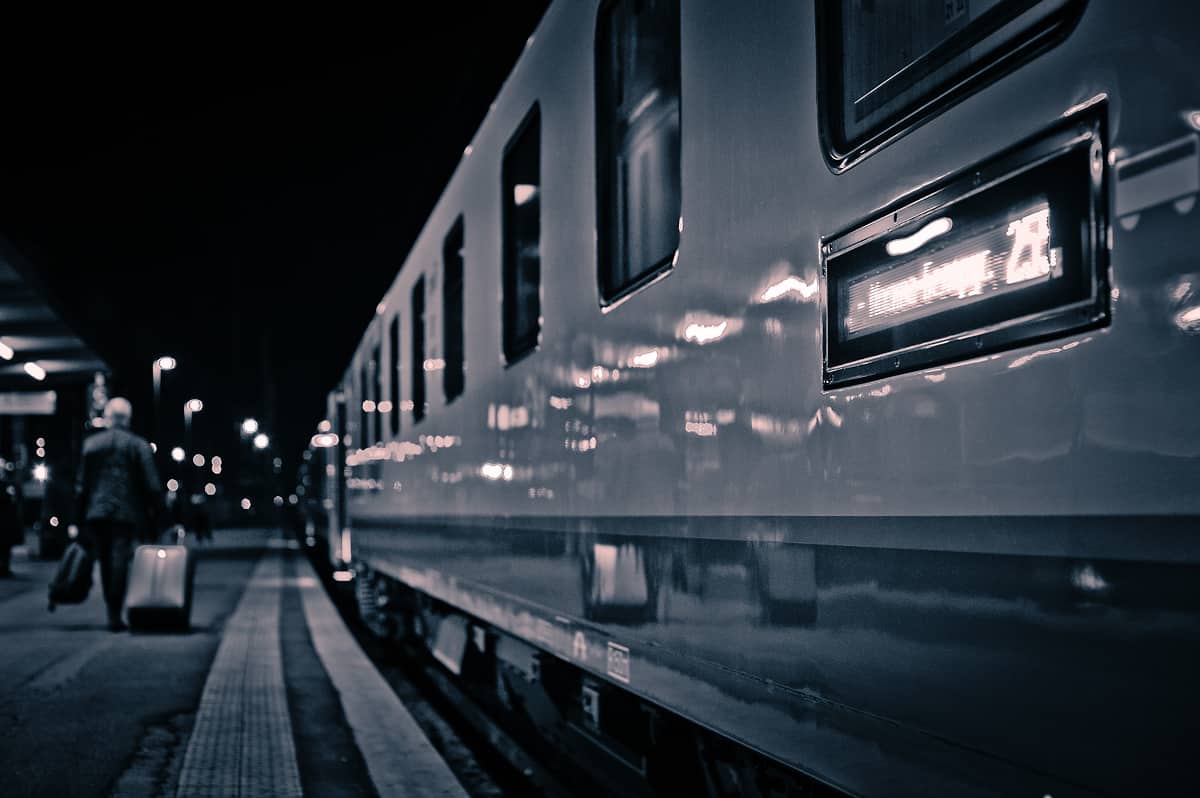
Please get on the train to London.
Just a few minutes after departure from Strasbourg we are already crossing the Rhine and reach German soil at Kehl. The train quickly speeds through the dark night, while our bottle of wine slowly gets emptier. We reach Karlsruhe, where the duty of our Class 181.2 multivoltage loco ends. It is replaced by a Class 120 which will bring us to Berlin. On the opposite platform we can see the car-carrying train from Lörrach to Hamburg with plenty of cars as well as a number of passengers waiting for the night train Zurich - Hamburg. As a passionate night train traveller you begin to think a lot about the current situation of night trains with many train companies in (Western) Europe thinking about withdrawing all of them. Lying in a modern and comfortable sleeping car the prospect of travelling overnight on board a regular train in seat doesn't sound too tempting...but I get carried away. Finally we decide to go to sleep, at least we have set the alarm early as we want to see the arrival of our train in Berlin.
Thanks to the comfortable mattress, a wide bed and the smooth running of the modern coach (and maybe the wine) I sleep very well, however the alarm mercilessly goes off around half past six. Looking out of the window I can see that we are already in the Berlin area. The S-Bahn stations are full of commuters on this grey Monday - if any of them notices our train? Might someone even have thought about taking the train to go to Russia? I don't know but would recommend it to each one of them already. It doesn't take long until we reach the tunnel that will take us beneath the city centre to the central station, Berlin Hauptbahnhof, where the train shortly stops before continuing towards Lichtenberg station. There, the train has a longer scheduled stop as it is once again time to change our locomotive. However, I don't notice much of it as I prefer to go to bed again to get some more sleep.
Berlin 07:50 - 13:47 Warsaw
Half an hour later we leave Berlin on time with our new loco in front, a multivoltage DB Class 186 that will bring us all the way to Terespol on the border to Belarus. It just takes about an hour to reach the German-Polish border at Frankfurt/Oder, where we cross yet another border river. Time to pay a visit to the restaurant car for breakfast. Unlike the sleeping cars which belong to Russian Railway RZD, the restaurant car that runs from Paris to Warsaw belongs to Polish long-distance operator PKP Intercity and is managed by caterer WARS, who are also servicing all other Polish restaurant and sleeping cars. Despite the early hour we are welcomed by loud party music playing from a laptop on the bar. Maybe this is a first taste of Russian culture? The other guests don't seem to mind, so we go along with it too and take a seat. As I did a bit of research beforehand I know that the menu isn't exactly cheap, especially if you compare it to prices in "regular" trains operated by WARS. Now I have confirmation in form of the menu. Anyway, how often are we going to eat in a restaurant car on the way to Russia? Exactly. Peter and I both go with scrambled eggs and a coffee to start the day. Everything is freshly prepared in the kitchen and tastes really good. Meanwhile the weather also got better and the sun starts peaking through the clouds.
After breakfast we head back to our compartment. The following hours will take us from west to east all across Poland. Wide open plains and large forests pass by outside the window. As the landscape is not particularly spectacular, you have more time to think, to talk with your fellow travellers or maybe read a book. I use the time to write a few lines about tickets for this train.
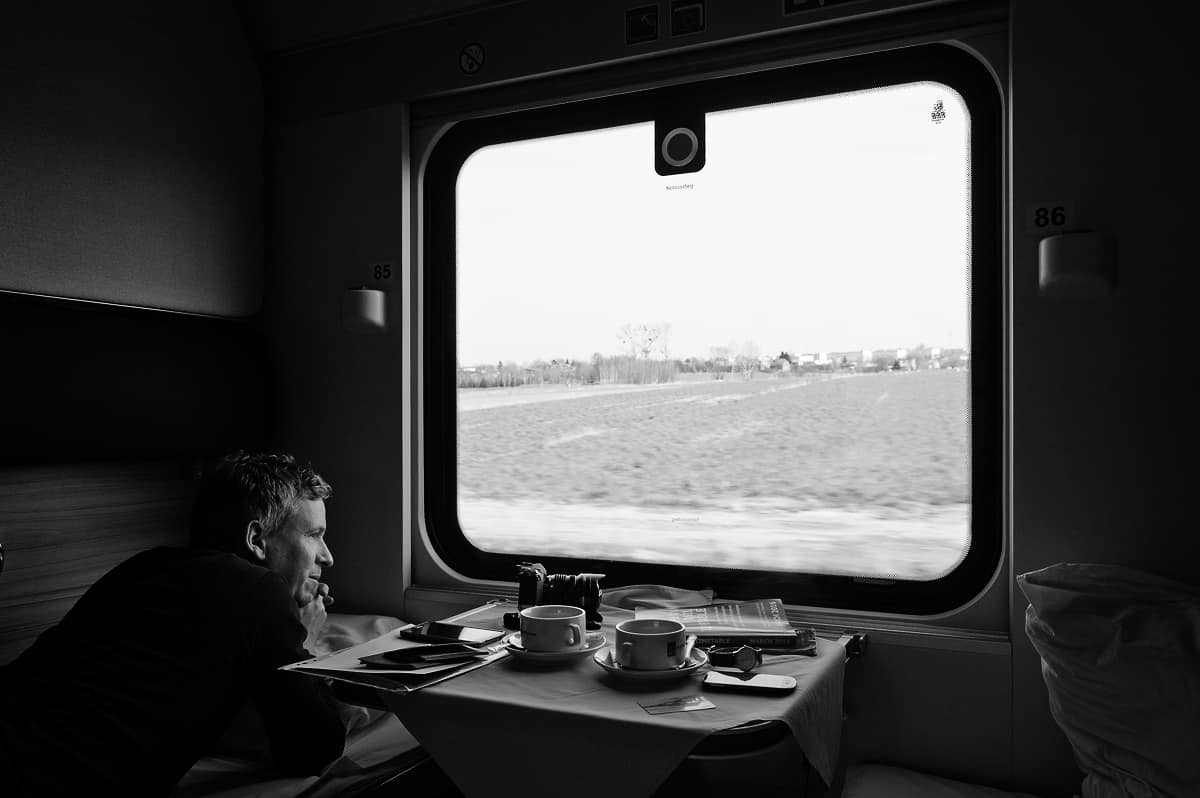
Time to travel, time to think.
Russian Railways RZD manage the train on its whole route in the EU, paying the national railway companies for locomotives, paths etc. That way, all revenue remains with RZD (as opposed to classic trains operated in cooperation by several national railway companies who then have to share the revenue). This means that tickets are only available as global price tickets for this particular train, "normal" international tickets are not valid. Tickets are available online from Russiantrain (bequemes Buchungssystem), Infotrain as well as from RZD and can also be bought at train stations in the countries the train runs through as well as in certain other countries.
Group travel Russia: if you want to travel with a whole group by train to or in Russia, we recommend you our friend Marine. Please contact her to get a quote: info@vitamin-b.biz . She is the specialist for group travel with Russian railways.
Tickets are available for 2nd class (4-bed sleeper), 1st class (2-bed sleeper) and Lux (large 2-bed sleeper with private bathroom). Besides the regular fare there are different reductions available for small groups of up to five people as well as larger groups of six people and more, for seniors, youths and families. Special discounts are available if you travel around your birthday and for newlyweds. For travels between Paris and Berlin, a discount is also available for Interrail pass holders. Unfortunately though, not all reductions are available everywhere. Fares depend on date of booking and travel, our ticket in 1st class from Strasbourg to Moscow was 390€. Tickets do not include meals. Tea, coffee and small snacks are available directly from the sleeping car attendants, and restaurant cars with a large menu are available between Paris and Warsaw as well as between Brest and Moscow./p>
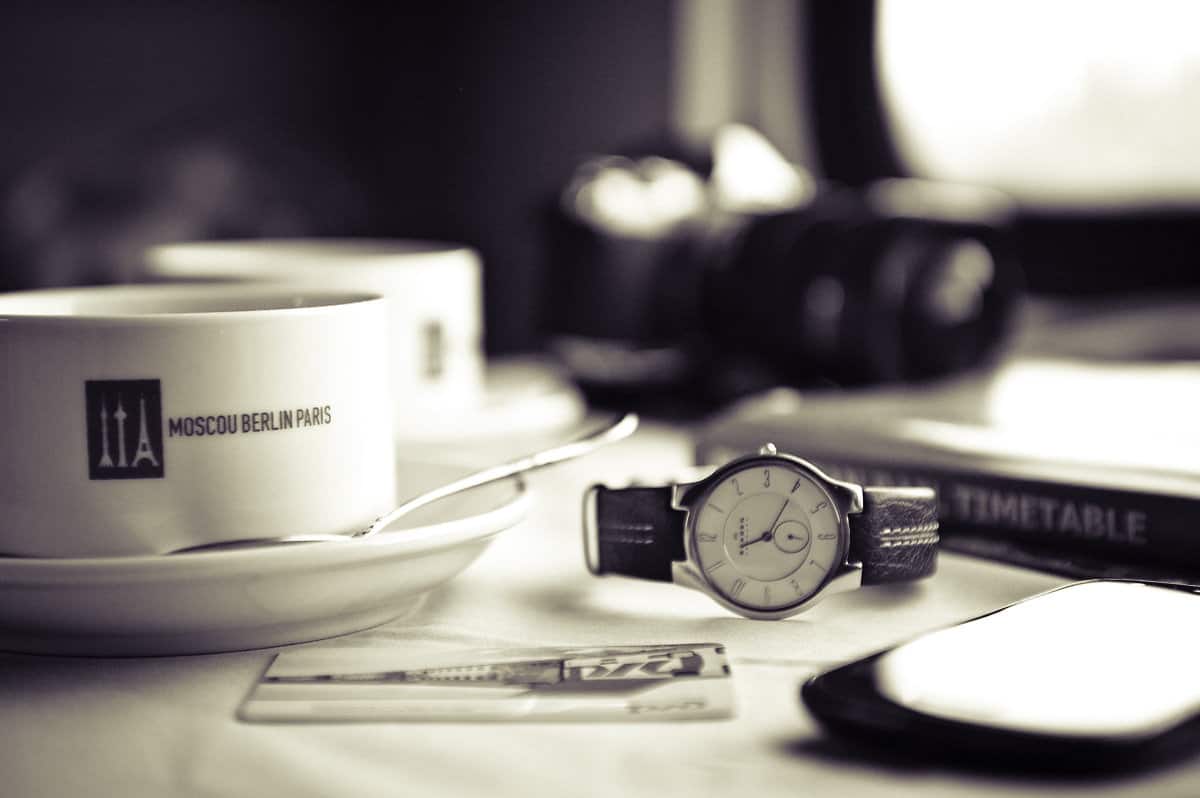
Coffee break.
Just after noon it is already time for our next visit to the dining car - as mentioned above, the Polish restaurant car is available to Warsaw only. During the following hours until the departure from Brest there will be no restaurant car available, before a Russian one is added to the train that then runs to Moscow. As we already know the large menu is rather pricey but does not lack specialities such as frog legs or kangaroo steaks which you probably won't find in regular restaurant cars. Also champagne and a wide choice of liquors are available of course. Only the vegetarian options are non-existent apart from a wide choice of salads, but this may also be due to some cultural differences. Since not much time has passed since breakfast both Peter and I opt for a small dish - in a Polish restaurant car you can't miss Pierogi, filled dumplings. While I choose the meat filling, Peter goes with the cheese Pierogi which turn out to be sweet. It tastes good nonetheless and with a glass of Tyskie we enjoy the meal while the train heads towards the Polish capital.
Finally we are approaching the suburbs of Warsaw. As the train's schedule is not too tight we arrive way too early and have to stop at Zachodnia (Warsaw West station) for a while before we are allowed to enter into the tunnel beneath the city to stop at Centralna, the central station. After the short stop, the train emerges into daylight again and crosses the Vistula. On one side we can now see the skyline of Warsaw, on the other the impressive National Stadium before the train stops at Warszawa Wschodnia, the eastern station. Here, the Polish restaurant car will be detached from the train. As it is positioned in the middle of the train the shunting manoeuvres take some time and we can get some fresh air on the platform. Peter also uses the break to change some Russian Rubels in the station, so that we can pay in the Russian restaurant car later in the evening. It would be possible to pay in Euro too but the exchange rate would not be too great though. That way we can also get our metro tickets right after arrival in Moscow. If you want to get to the station building during the longer stops of the train, just tell the conductor that you will leave and promise to be back in time (five minutes before departure latest).
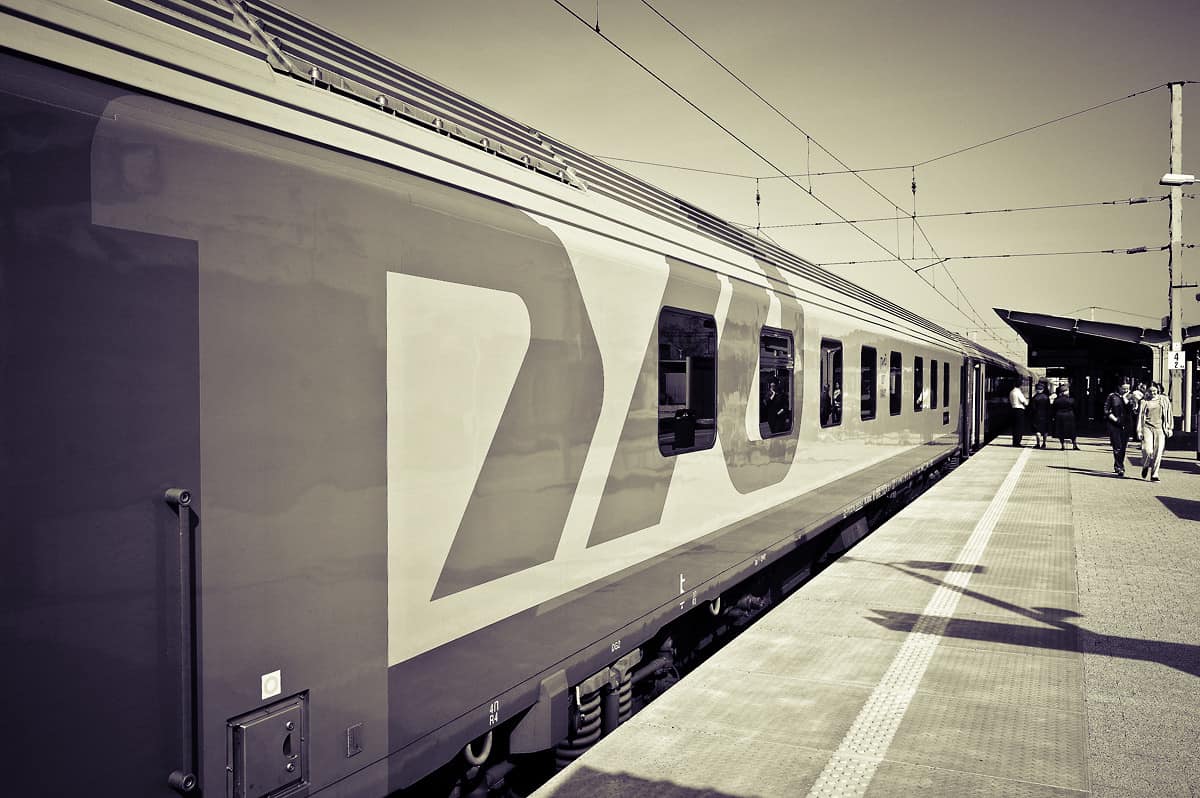
Warsaw. Time to get some fresh air.
Warsaw 14:17- 19:50 Brest
Leaving the restaurant car behind we continue towards the border of the EU at Terespol. The landscape doesn't change much, the only thing we notice is that the forests are now not only dominated by birch trees but are a mixture of birch and pine. We have to order yet another coffee to fight the afternoon fatigue. The trip to the border station of Terespol takes about two hours and is widly unspectacular until you reach the widespread freight yards with both broad gauge and standard gauge tracks that sprawl over kilometres before the actual station. Freight trains coming from Russia and Belarus run into Poland where freight is transferred to standard gauge trains towards the rest of Europe. Finally the train stops at Terespol and we eagerly wait for the things to come.
During the following hours we are going to witness scenes which are long gone within Europe: comprehensive border and custom controls and the change from normal to broad gauge result in the train covering just the few kilometres across the border river Bug to Brest, the Belarus border station. Nonetheless it is interesting to experience all these procedures so time passes by rather quickly. After the arrival at Terespol, our loco that brought us all the way from Berlin leaves the train and is replaced by an EP07 of PKP Intercity that will bring us only the few kilometres into Brest. During the change of engines Polish custom and border police officers get on the train and start checking all passengers. As expected they just have a quick look at our bags and passports and we are good to go. Until the departure to Belarus we see a freight train coming from there arriving a few tracks away from us. We notice how tiny normal gauge coaches look beside the huge broad gauge coaches and can watch Polish officers immediately boarding the coaches to inspect the cargo thoroughly. While we are waiting for the train to continue we also think about changing the time on our watches and mobile phones (and cameras, too...). The time difference in Russia and Belarus normally is +2 hours, however during daylight saving time in middle Europe the time difference is just one hour as both countries have abolished daylight saving time.
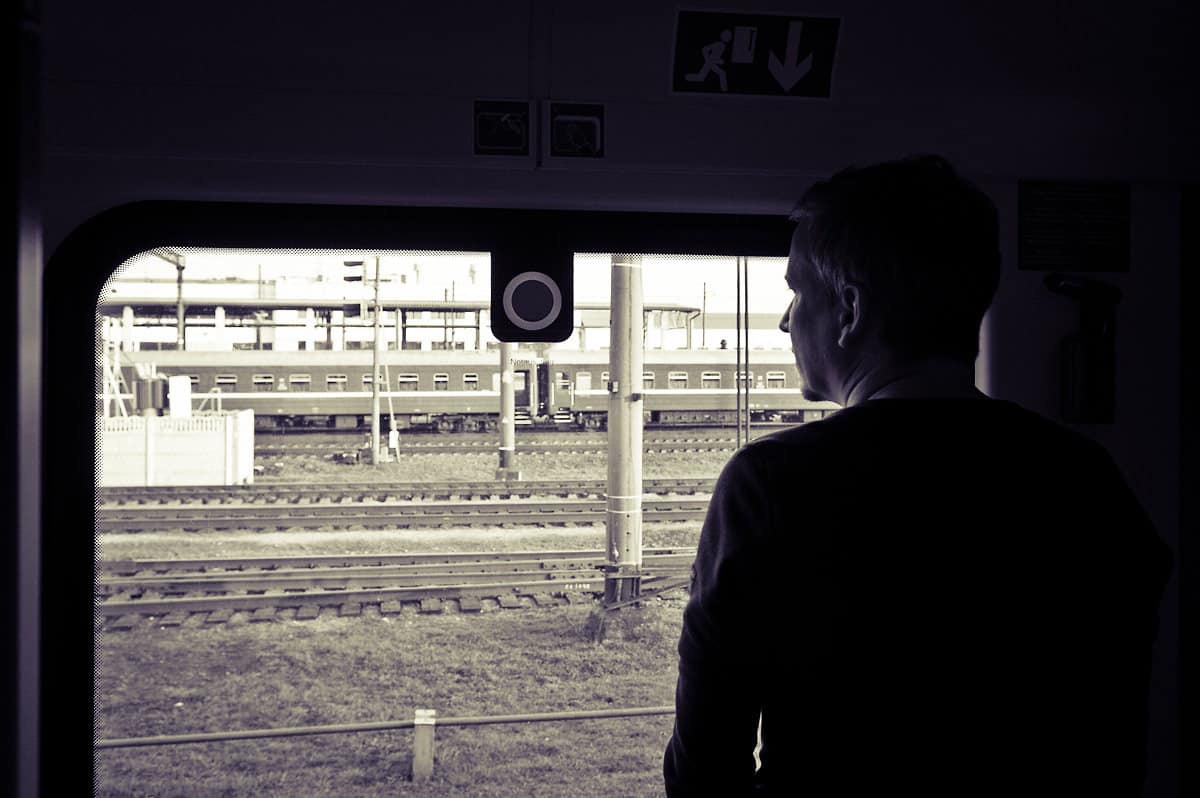
What is waiting for us in Belarus und Russia?
Finally we are on the move again, the train rolls towards the border and after a few hundred metres we reach the bridge across the Bug. We slowly pass the bridge and can spot the first Belarus soldiers closely watching the train. Then we stop and Belarus border police and custom officers enter the train, all in spotless uniforms with impressively large peaked caps. Shortly afterwards a custom officer enters our compartment and asks if we have anything to declare. We shake our heads which is enough for him to continue to the next compartment. He didn't even bother to have a closer look at our backpacks which I find quite surprising. Before the trip I had some doubts about the custom rules especially regarding our camera equipment, laptops and mobile phones but apparently the officer didn't care to have a closer look so we were good to go (of course we didn't break any rules...). A few minutes later border police arrives in our coach. The officer checks our passports and visa, then hands us two small sheets of paper. The migration cards have to be filled in with personal data, visa and passport number, and dates of entry and departure. While we think about how to fill in the migration cards correctly, she continues to control the other travellers. As she returns we are still unsure about how to fill in certain parts. Obviously we look a bit helpless so the officer takes a seat and helps us filling in the cards correctly. We are quite surprised about how friendly and helpful she is, especially since we expected the officers to be rather stern. By the way, the parts where we struggled are "name of host person or company, locality" (we were told to simply enter "Moscow") and "duration of stay", where we should enter the day of entering Belarus from Poland and the day of leaving to Poland. The main reason of our confusion was that the migration cards are issued for "Belarus/Russian Federation" but thanks to the friendly officer we could sort that out. We then get back our stamped passports and one half of the migration cards - the other one has to be kept during our stay and will be collected when we leave Belarus one our way back to Paris.
Peter and I both got our transit visa for Belarus and tourist visa for Russia through visa agencies. Although this is more expensive than organising the visas on your own at the consulates, we opted for the agencies as we did not have much time and did not want to risk any delays due to wrongly filled in documents. If you have more time for planning your trip you can also get the visas on your own. Keep in mind though that you will need an invitation to apply for a Russian visa and that the Belarusian transit visa is issued only when you already have the visa for Russia. Also needed are travel insurances valid for both countries. More information is available on the websites of the foreign ministries of Belarus and Russia.
After we have successfully passed the remarkably friendly Belarus immigration checks we are a bit more relaxed and can now have a look at all the interesting things going on outside the train. We can spot a large military facility beyond the trackside trees, then reach the area where the bogie exchange will take place later on, with endless lines of broad gauge and normal gauge bogies outside the large hall. Before that we stop at the Warsaw side of Brest station. The grand building gives a first taste of what to expect on the broad gauge network. Everything seems to be slightly larger as we know it from European railways. After a short stop for disembarking we continue a few hundred metres and stop outside the station. Here, the tanks of the bathrooms are cleaned and filled with fresh water, then the train slowly reverses back to the bogie exchange hall.
For anyone interested in railways probably the most interesting part of the journey is about to happen in the following hour. The train is converted from European normal gauge (1435mm) to Russian broad gauge (1520mm). This is done by replacing the bogies of each coach. The train is uncoupled and each coach is positioned at a hydraulic hoist. With the help of a crane the screw-type couplings are removed and replaced by Russian automatic couplers. Now the wagons are lifted off from the bogies by the hydraulic hoists and the bogies are pulled away by a cable winch. From two metres above ground you then see the new broad gauge bogies being pulled into the hall from the other end. They are then positioned below each wagon before they are lowered again and fixed to the new bogies. The whole procedure is a well-rehearsed routine for the staff and after an hour we leave the hall, now running on broad gauge rails. The coaches are coupled together again and and a Russian restaurant car and domestic sleeping car are attached to the train. We then slowly roll to the Moscow side of the station where not only passengers are waiting for the train but also numerous vendors offering water, beer and homemade food to passengers. Sadly we can't buy anything though as we have planned to have dinner in the restaurant car.
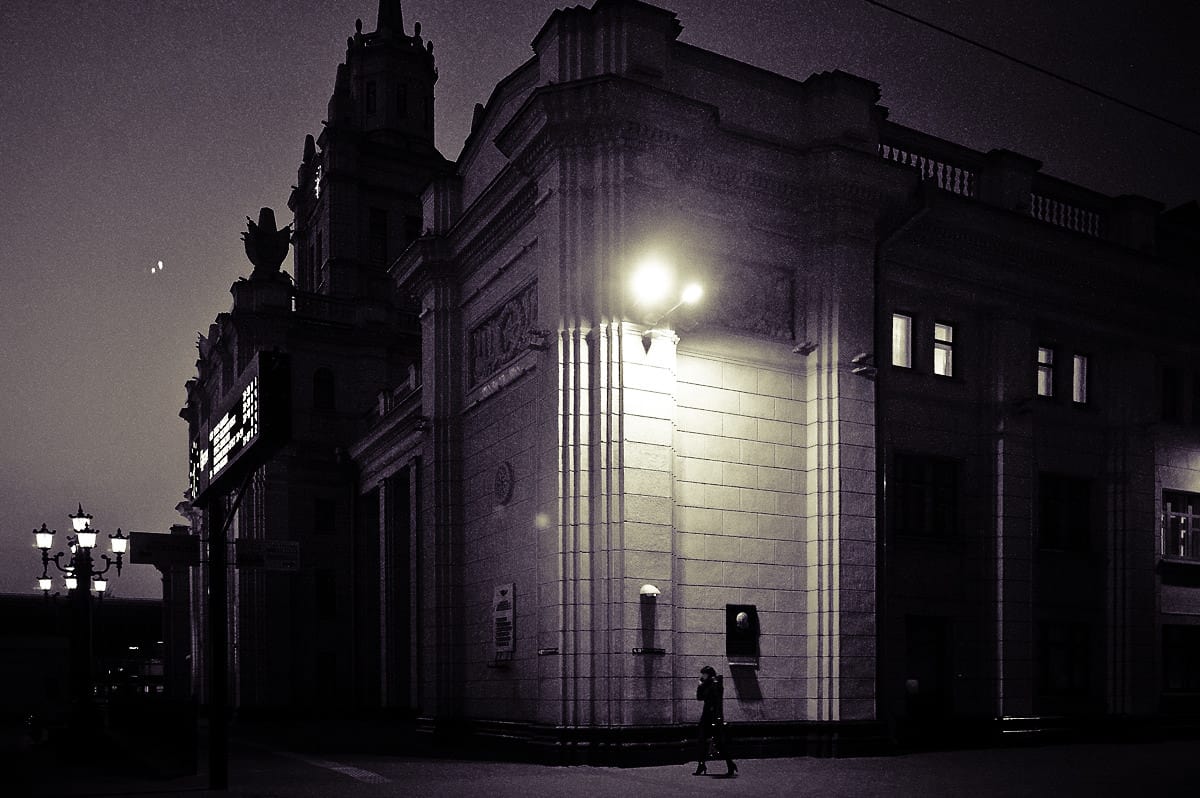
Night is falling in at Brest.
Brest 21:07 - 09:21 Moscow
While our train waits at the platform for the departure signal, we already head to the restaurant car for dinner. As mentioned above, there is a Russian dining car on the train between Brest and Moscow. We are again greeted by loud party music from a laptop at the bar but this doesn't really surprise us anymore. We are the first customers of the evening, prompting the personnel (chef, head waiter, waitress) to quickly end their conversation and busily preparing everything for dinner. The tables are already beautifully set with crockery and cutlery though. Once again we are about to enjoy dinner in a dining car however this time it is quite special. The last hours were a bit stressful, I was constantly worried that there might be some issues with the visas or at the border checks in general. All went well though so we can now drink to a (so far) great journey. The menu is similar to the Polish restaurant car without any vegetarian options except for starters and salads so Peter has to go with the salmon while I choose the "Stek". We order Russian beer - there are plenty of foreign beers available but we usually prefer local beers. Prices are cheaper than in the other restaurant car, which might also be due to the good current exchange rate of the Rubel.
While the night sets in the train accelerates and we are on the move again. From Brest the train is pulled by a TchS8, a huge double-locomotive of RZD. Meanwhile we are still waiting for our food to arrive. Finally it arrives and the kitchen surprises me as they serve salmon instead of steak. Apparently some kind of miscommunication but as I am really hungry and the salmon is really delicious too I don't really care. The long waiting time could also be due to the fact that probably everything, including the potatoes, was freshly prepared. To finish the evening we order another Zatecky Gus and enjoy the trip into the dark night, our second night on rails. If you have any questions regarding the menu of both the Russian and Polish dining cars, just ask, we made pictures of the complete menu.
Finally it is time to go back to the our compartment to get some sleep. Unlike on normal gauge rails the coach is shaking and rattling much more, probably due to the track conditions and/or the different bogies. We still debate whether we should have breakfast in the dining car tomorrow but leave the decision until the morning. I have a shower, then go to bed, pondering if there will be another custom and immigration check at the border between Belarus and Russia early in the morning. I'd prefer to sleep through of course...
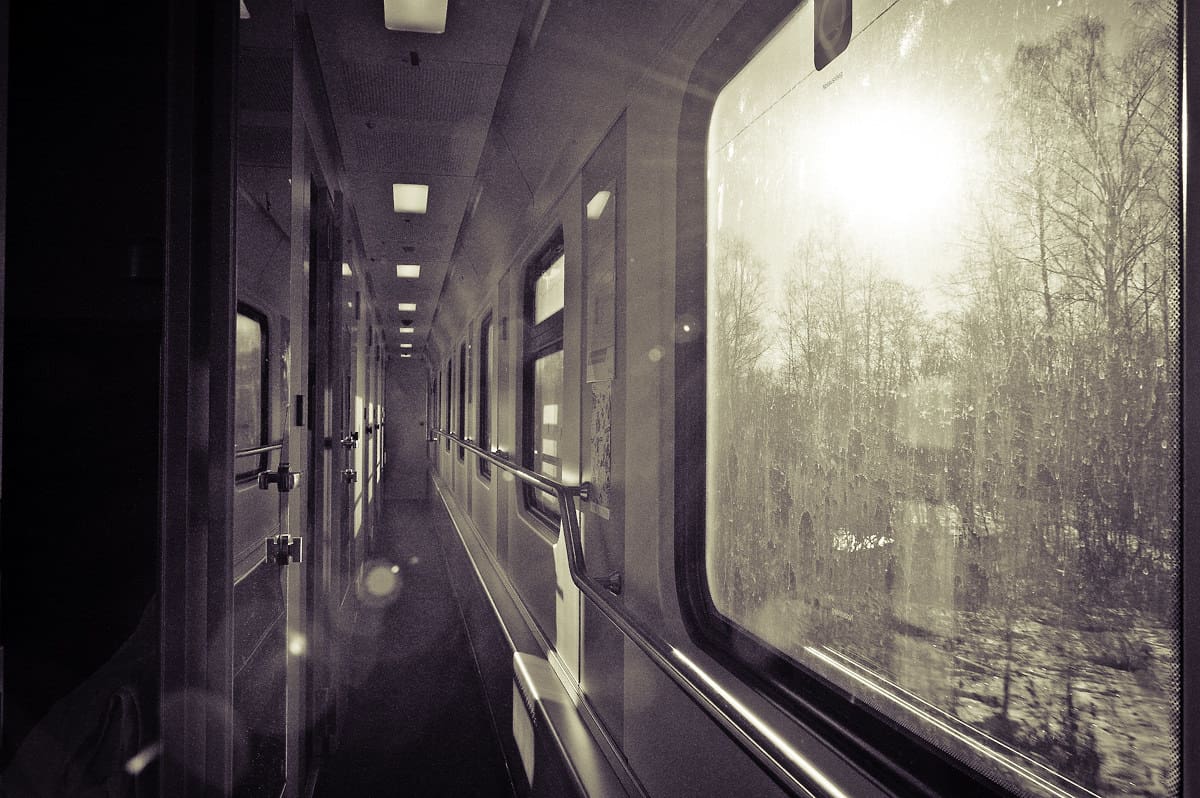
Russia welcomes us with bright sunshine.
The following morning I wake up as I hear a Russian voice through a loudspeaker outside the train. Sleepily I peak through the window and see the large station of Vyazma in the morning sun. So we are in Russia already and there have been no checks at the border. At Vyazma the final change of locomotives takes place before we tackle the last few hundred kilometres to Moscow that will take us through a sparse landscape. Only now and again you can see a few small wooden houses through the trees. Sometimes there are also small stations in the middle of nowhere which sometimes don't even have a proper name but are just marked with the track kilometre. We decide not to have breakfast and instead just order a coffee from the conductor. By the way, if you wish to have breakfast on your journey you could also order it to be served in the compartment.
About one hour before the train reaches Moscow the landscape outside slowly starts to change. We are approaching the outskirts of the 10 million megacity. Cities and villages are more numerous and get larger and larger, local trains are more frequent. Time to pack our bags and say goodbye to our home for the last almost 36 hours. We hand back our key cards to the conductor and receive our tickets in return. We also pay our bill for coffee and tea, not without giving her a tip (in Euro). She is really happy but definitely has earned it she was so friendly and our coach was spotless during the whole trip. The train slowly makes its way through the suburbs of Moscow, crossing the Moskva river and passing by the impressive Moscow City. Finally we reach the yards of Belarusian Station and approach the platforms at walking pace before the train comes to a stop in front of the buffer stop. We have reached Moscow.
So this is the end of our journey then. An impressive and fascinating trip lies behind us. Of course the long journey time will not suits everybody's needs but if you have the time at hand and enjoy travelling by train you are up for an unforgettable journey. Seeing the landscape outside the window change, eating in the dining car, the whole atmosphere of the train - all this makes this journey to something special.
I hope that you enjoyed the report and had fun reading. More photos of our trip to Russia as well as from our return to Paris will follow here over the course of the following months. Meanwhile, have a look at my Instagram for pics of this and other trips. If you have any question regarding the night train, booking of tickets or Moscow and Russia in general feel free to ask your question in the large rail.cc forum. Maybe you feel inspired to make a similar trip, you definitely won't regret it.
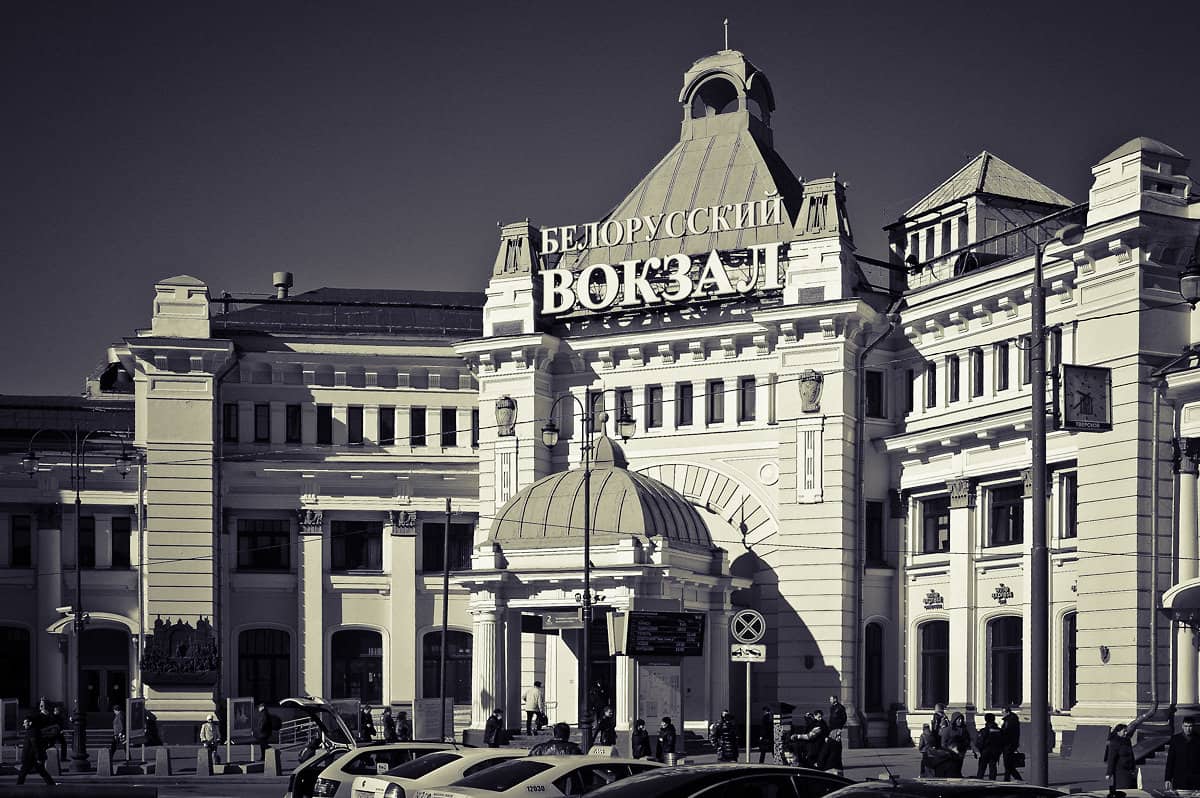
Terminus of our train: Belarusian station in Moscow.
Update: April 2018
👁 51833

